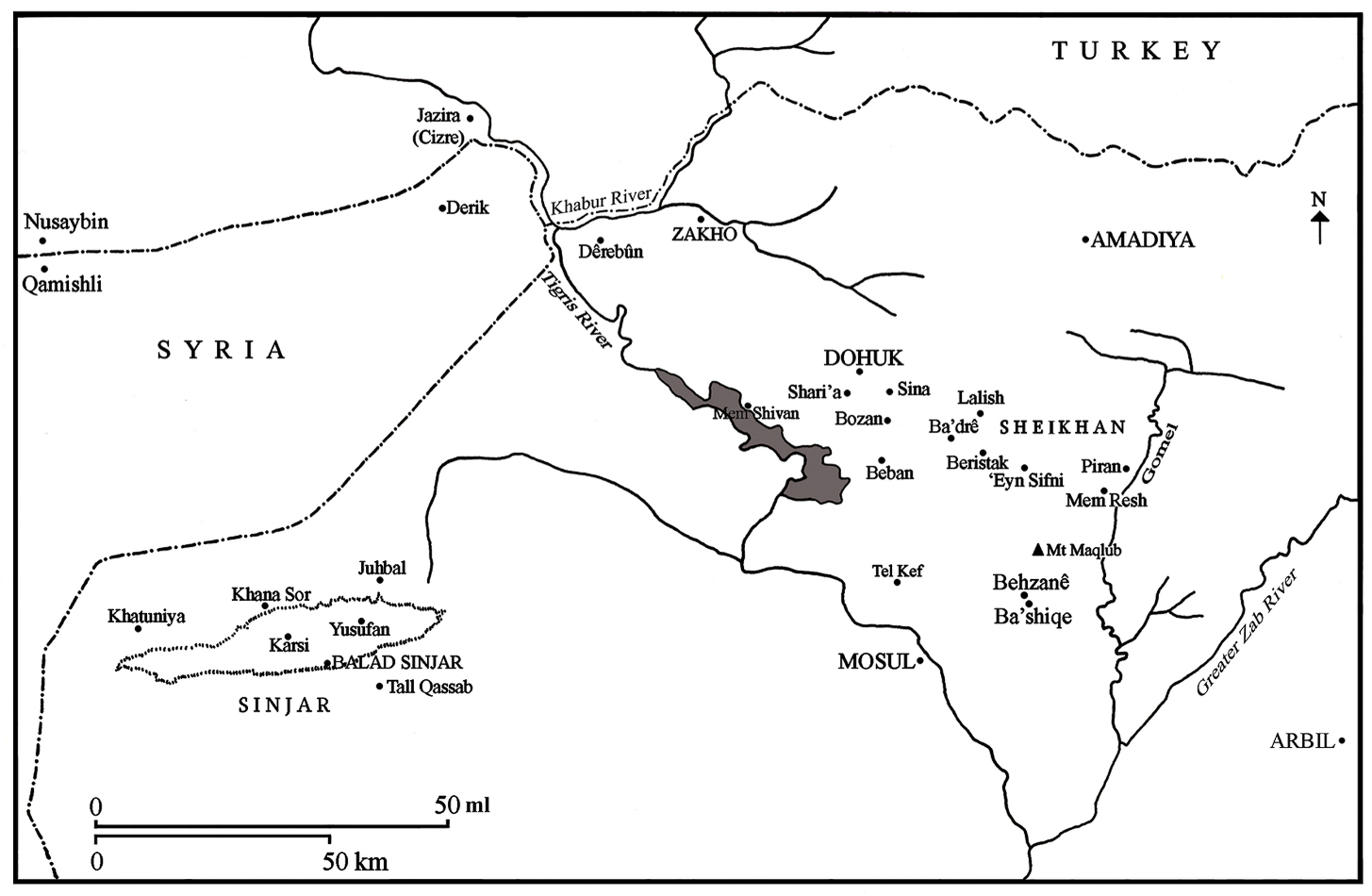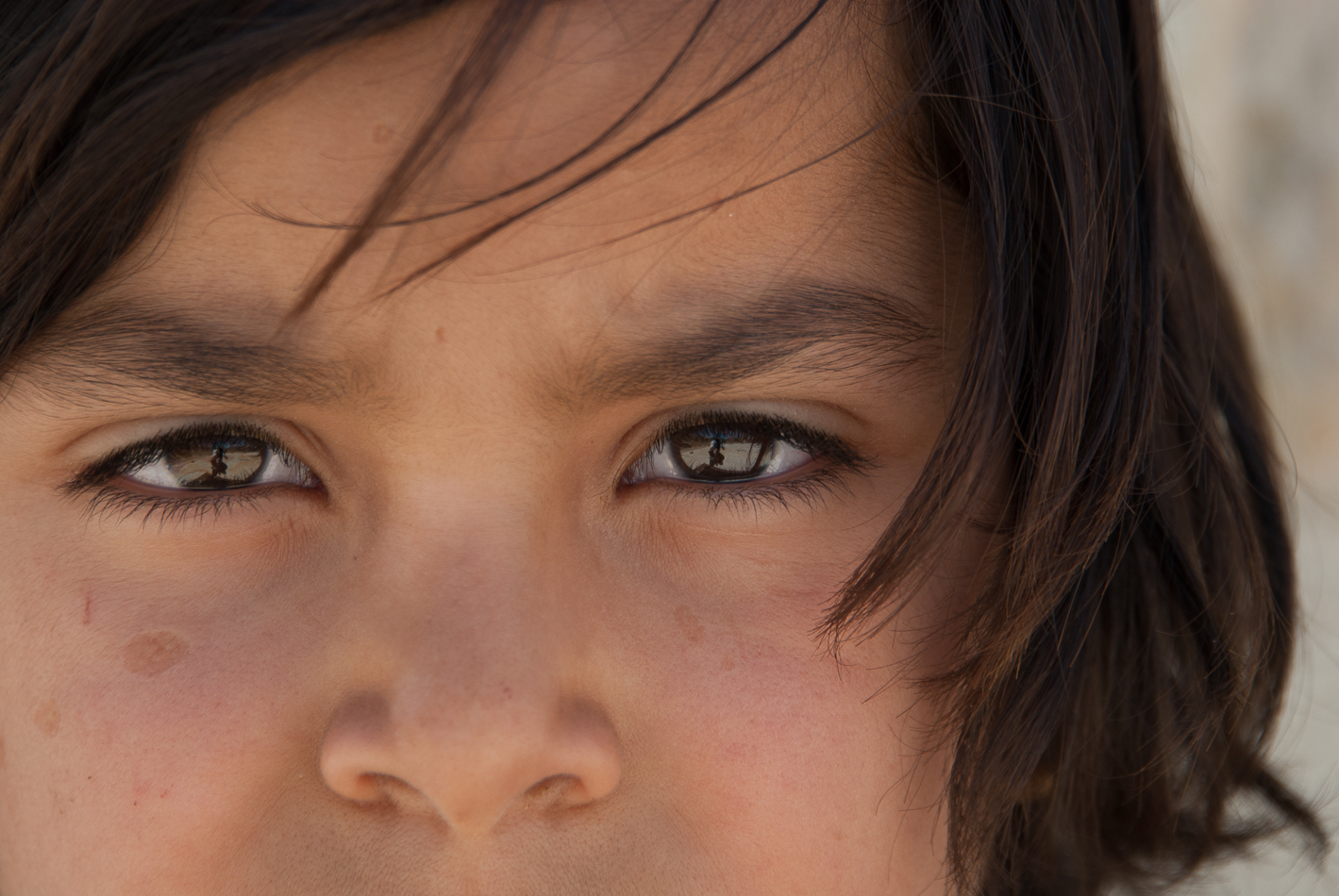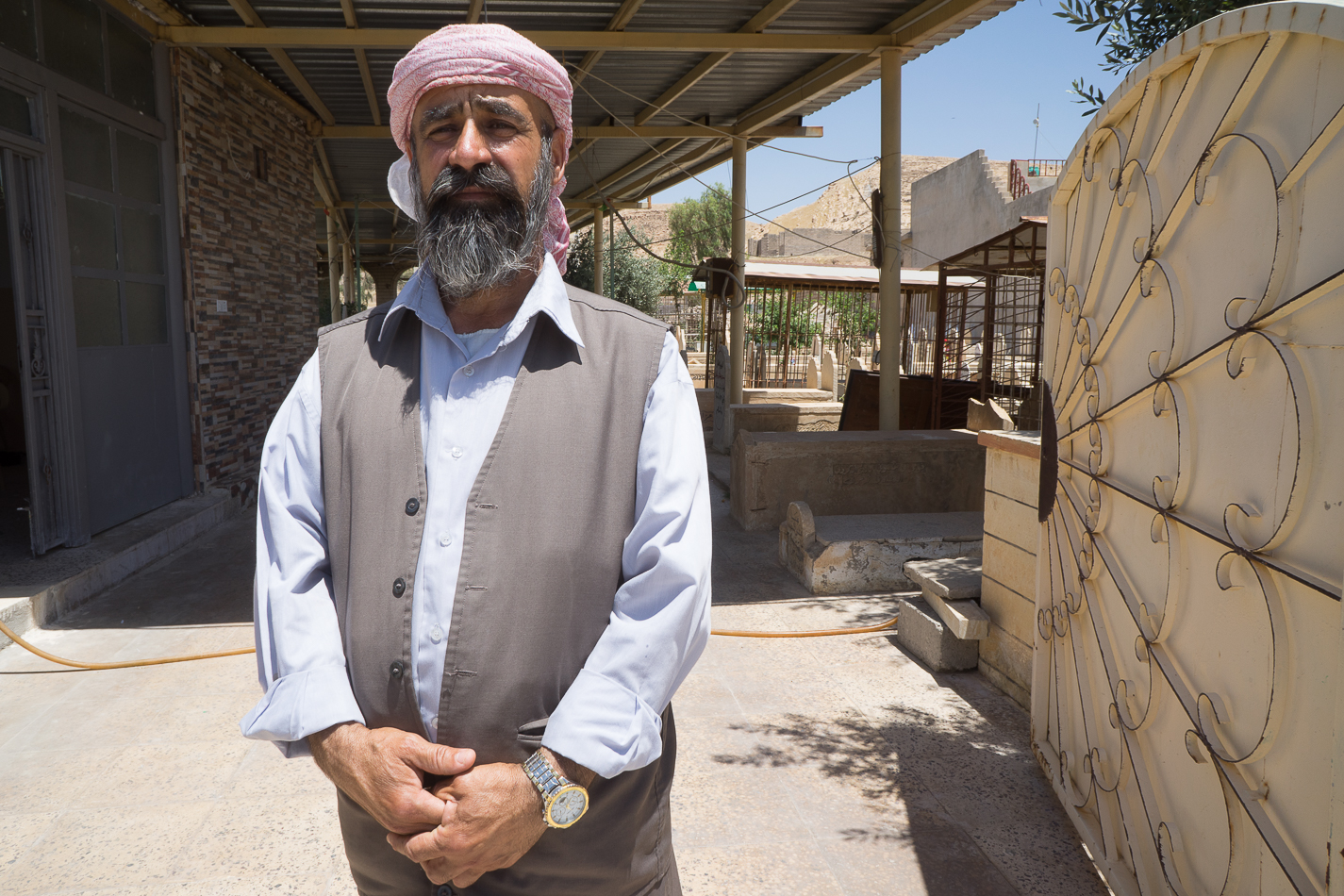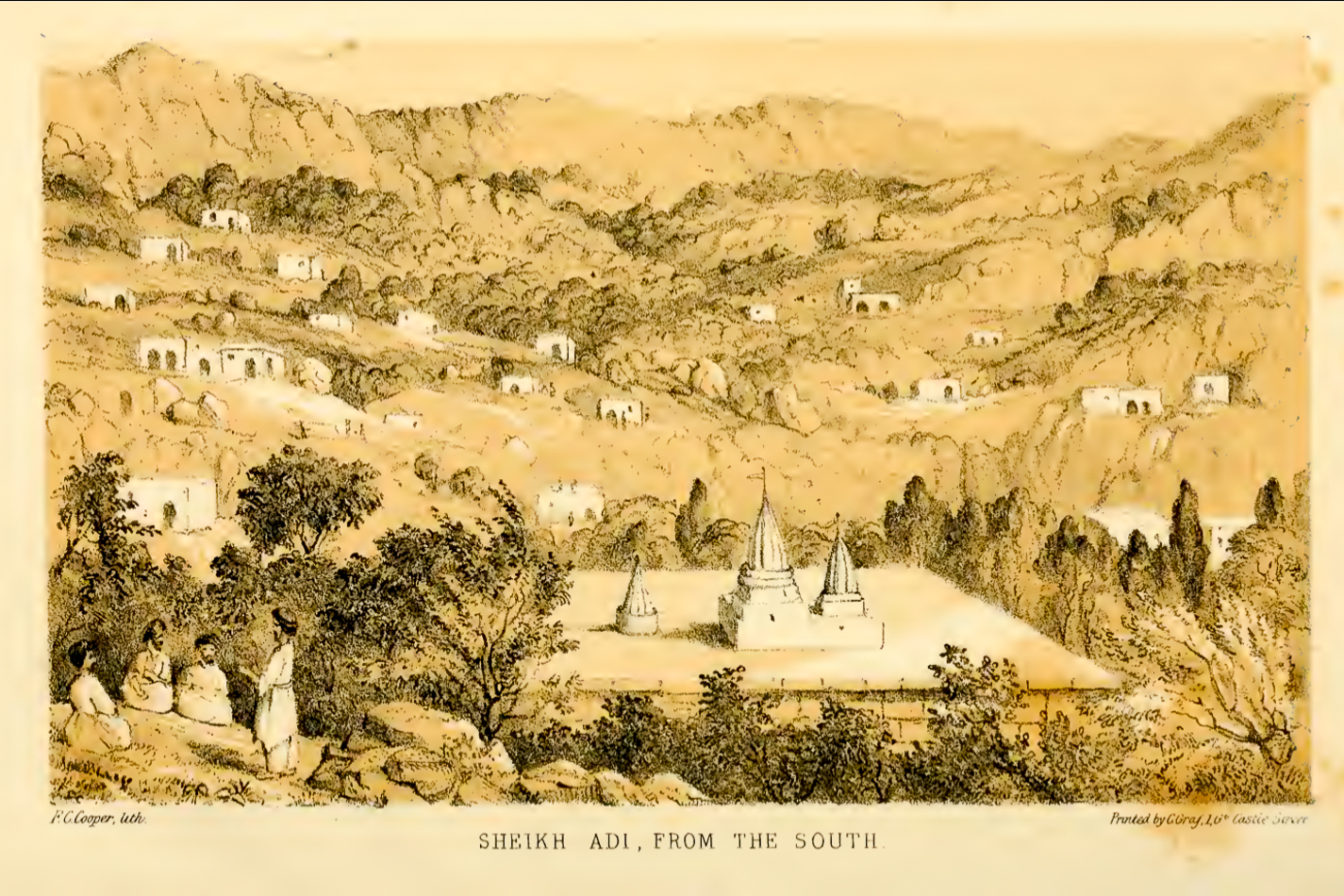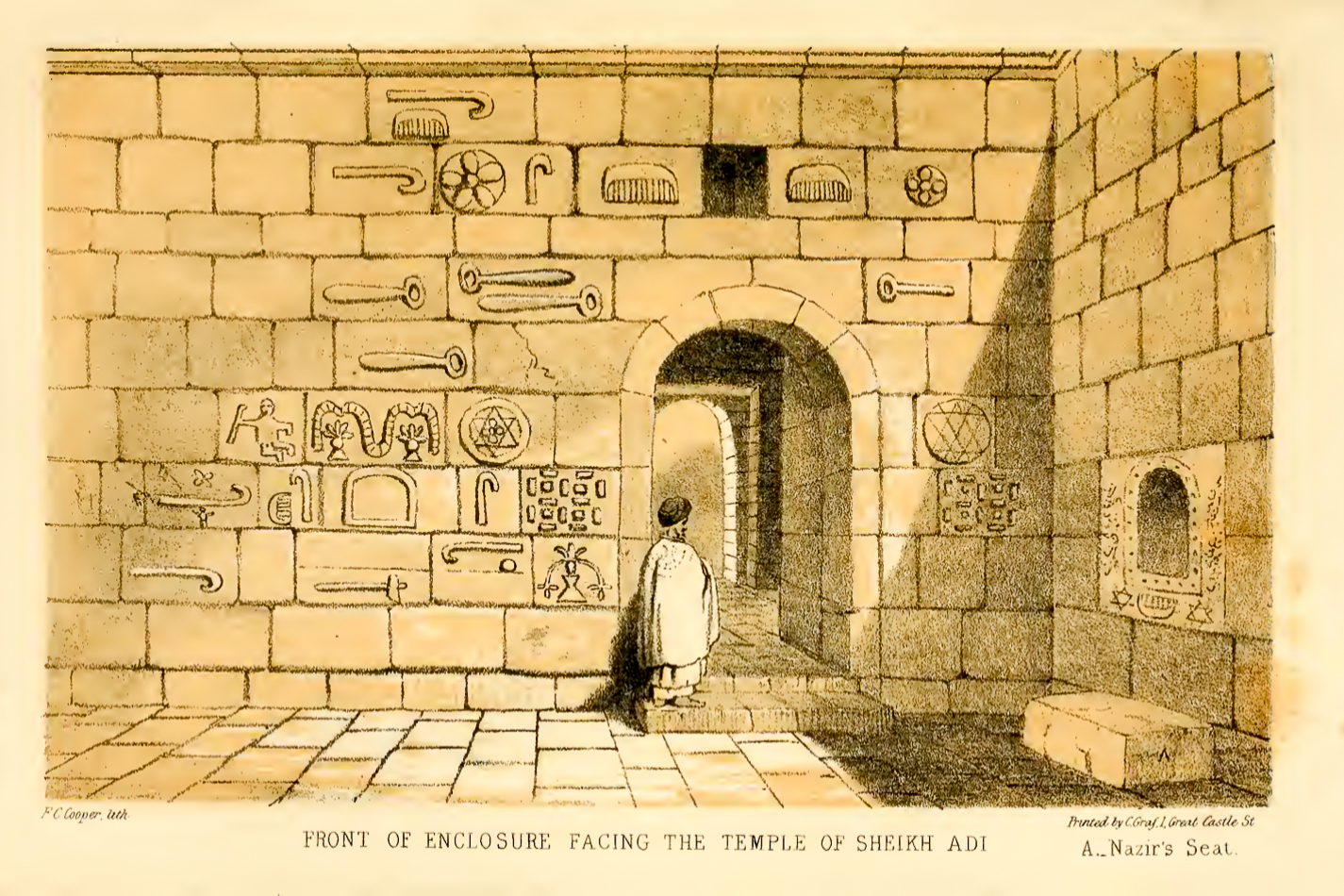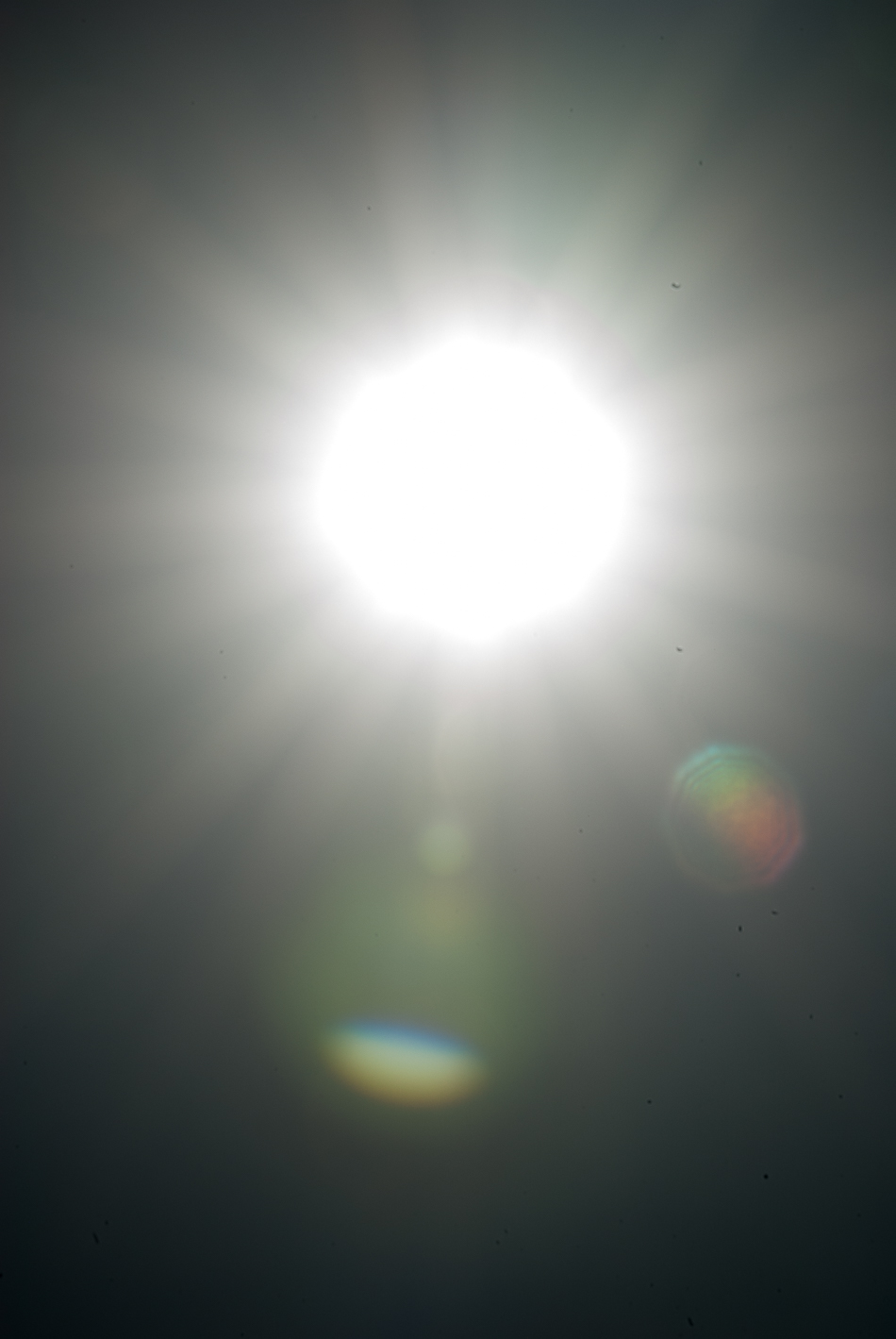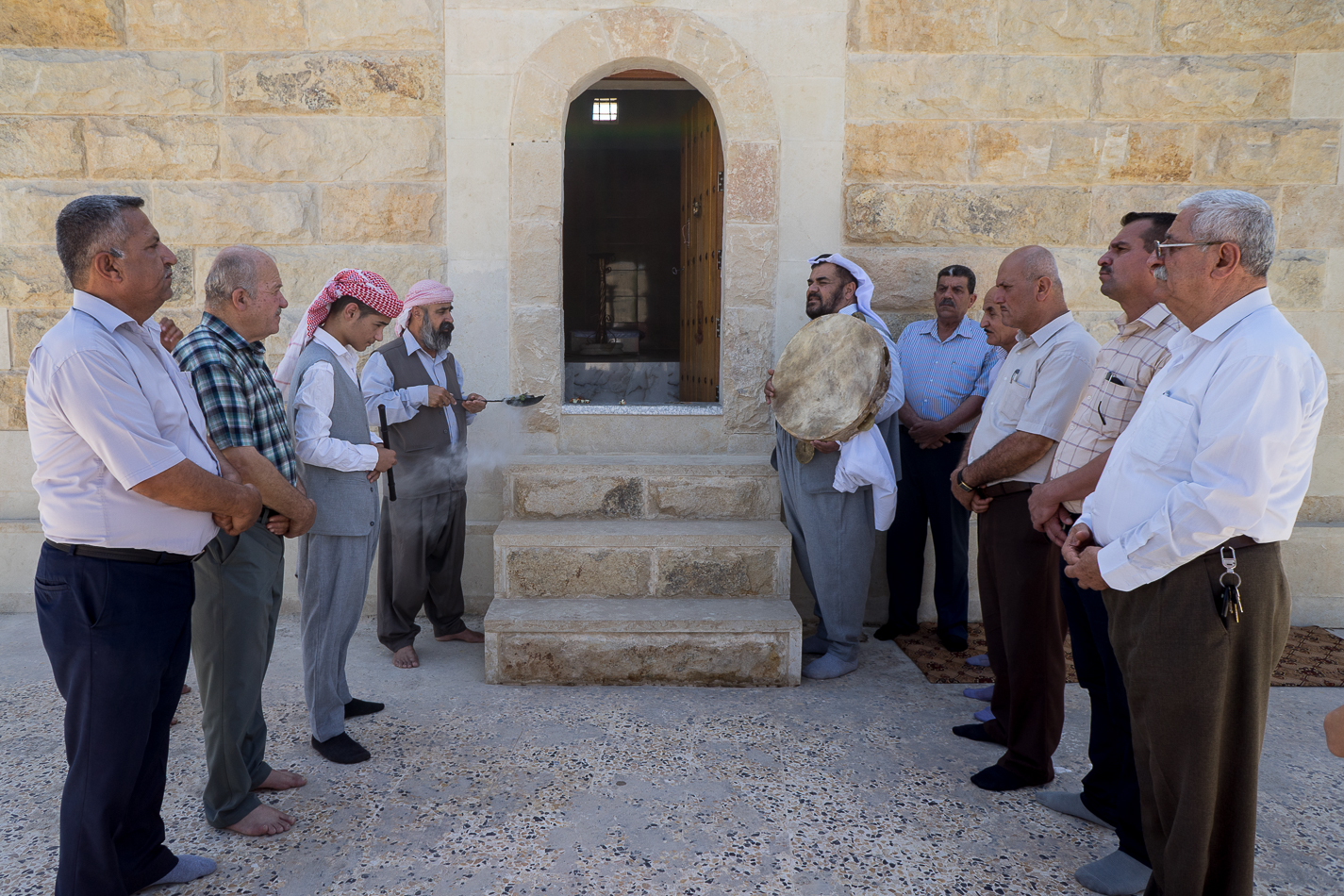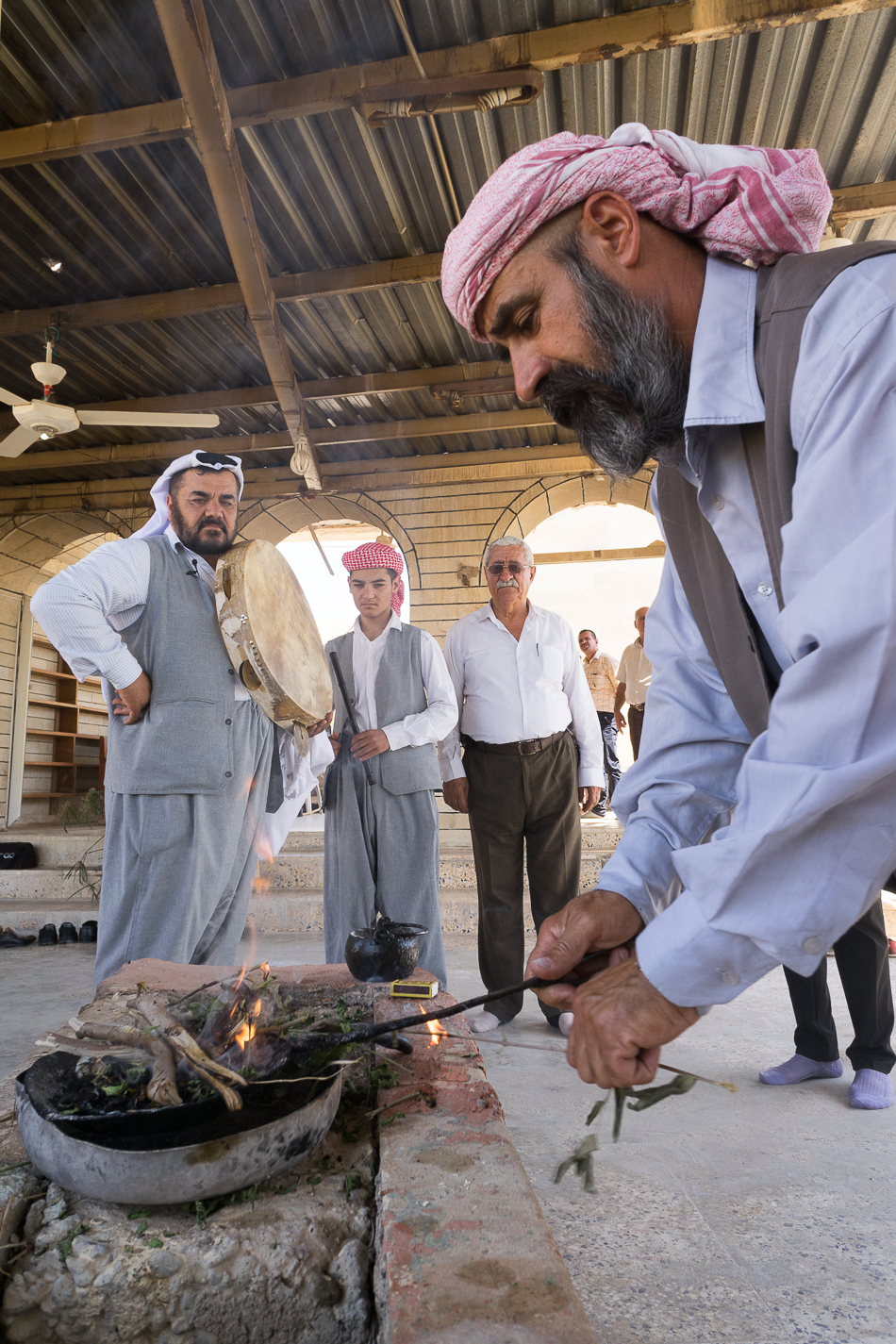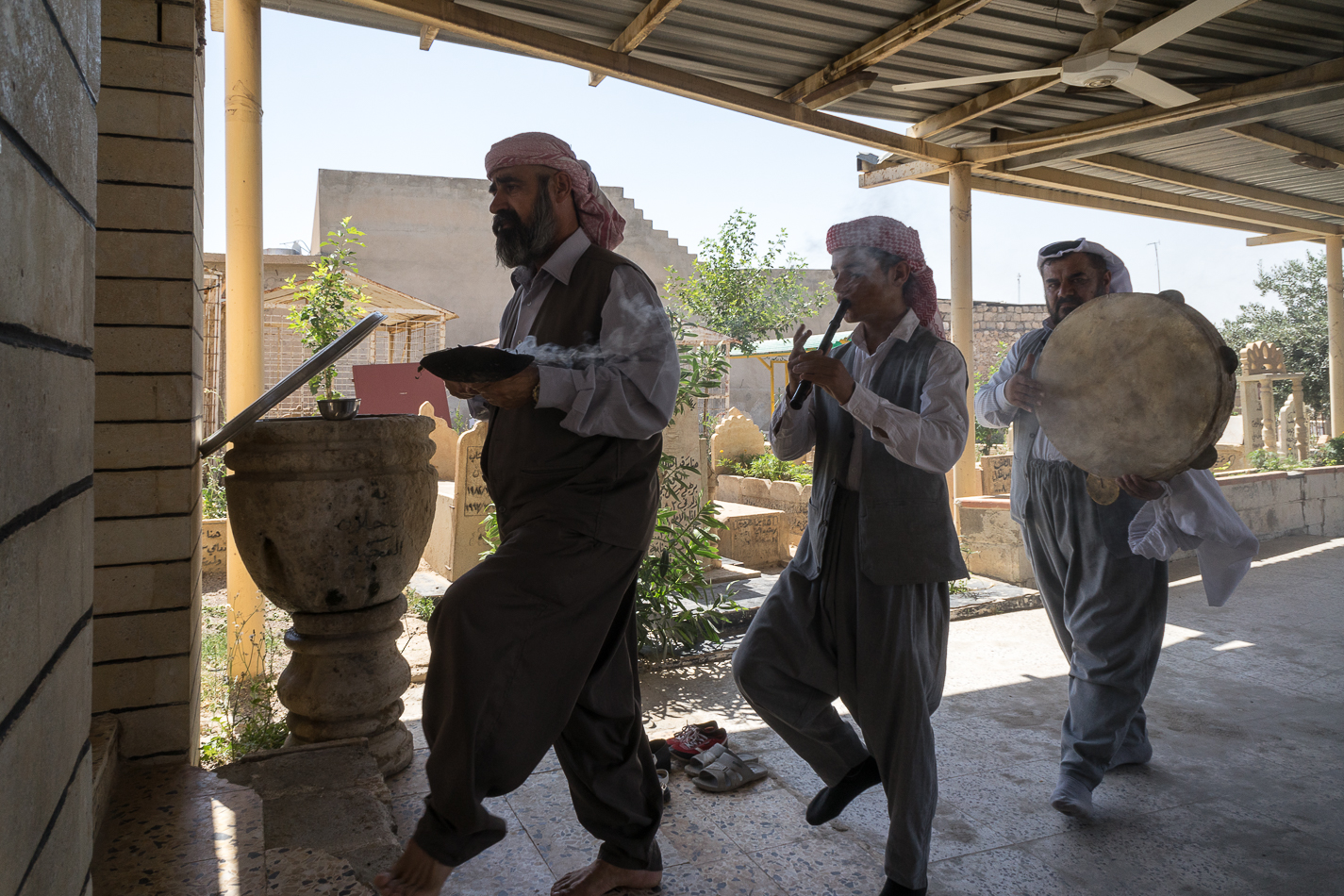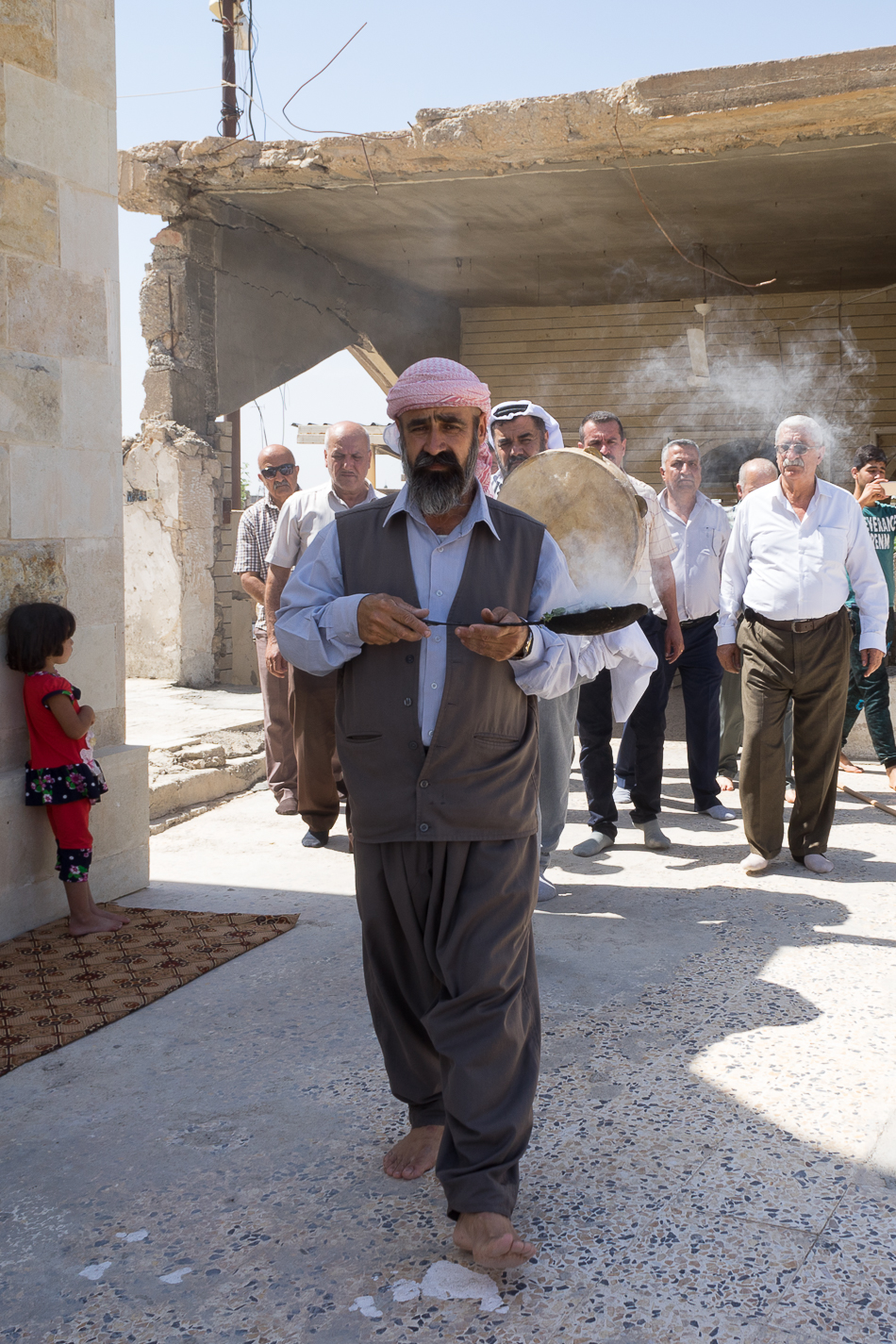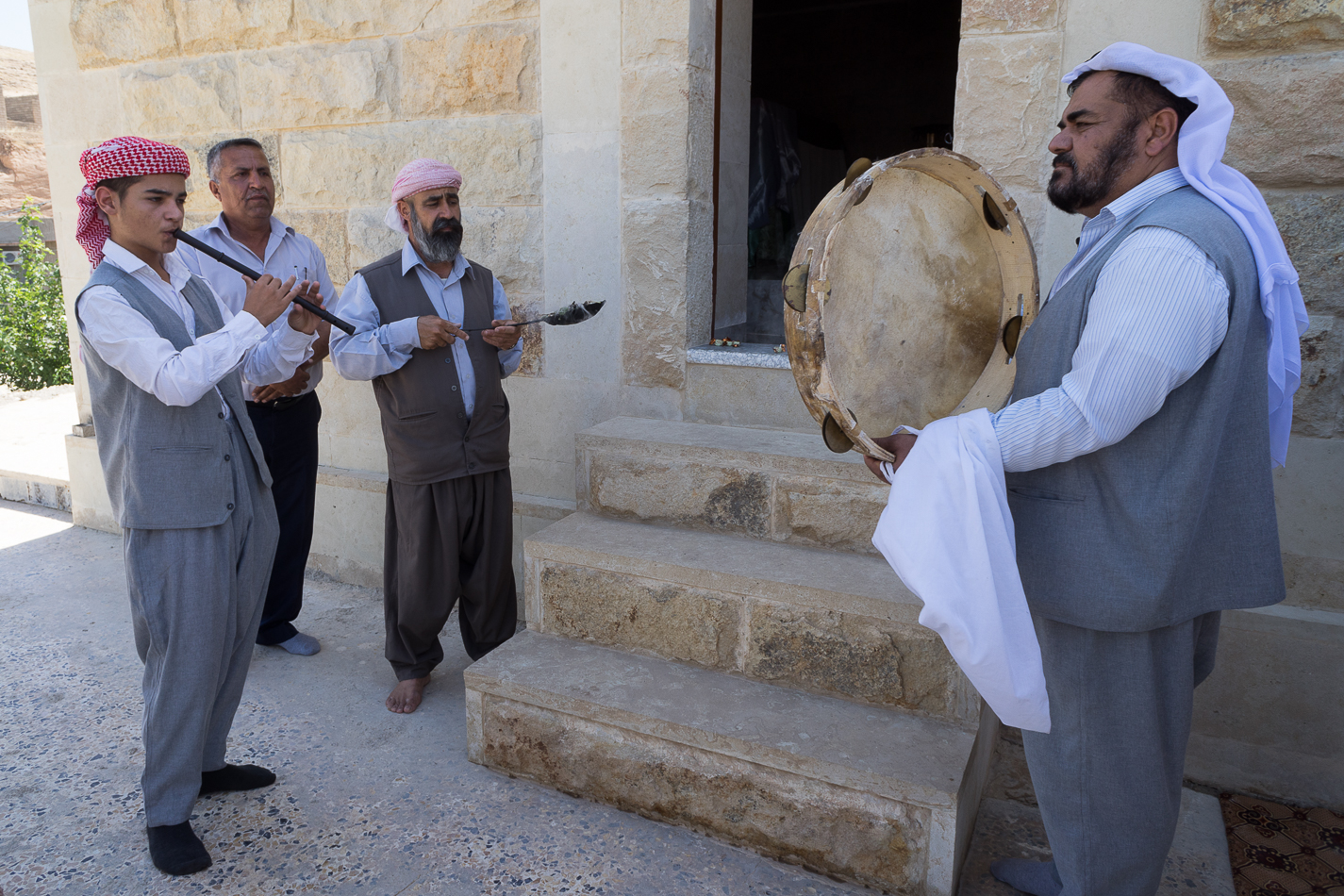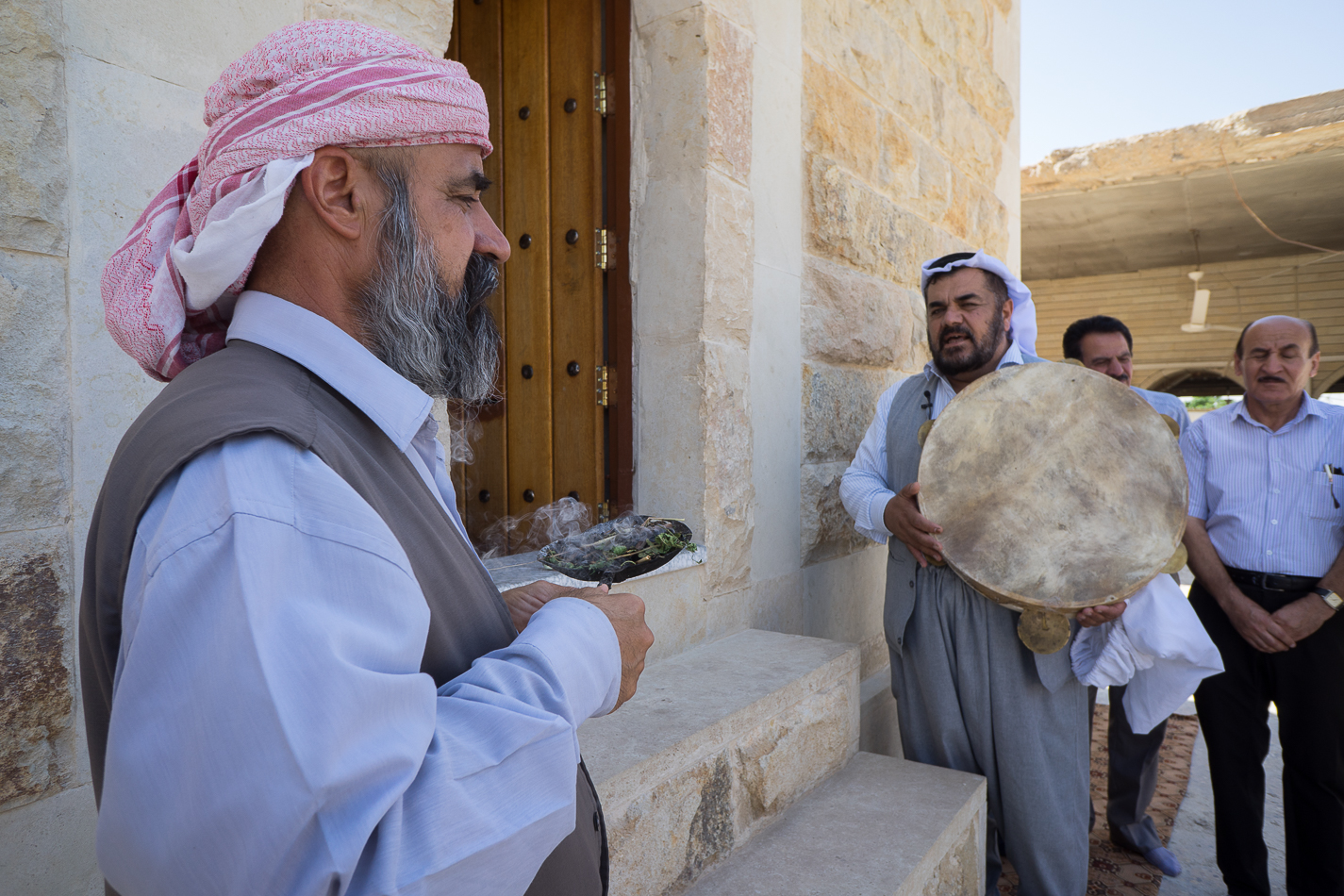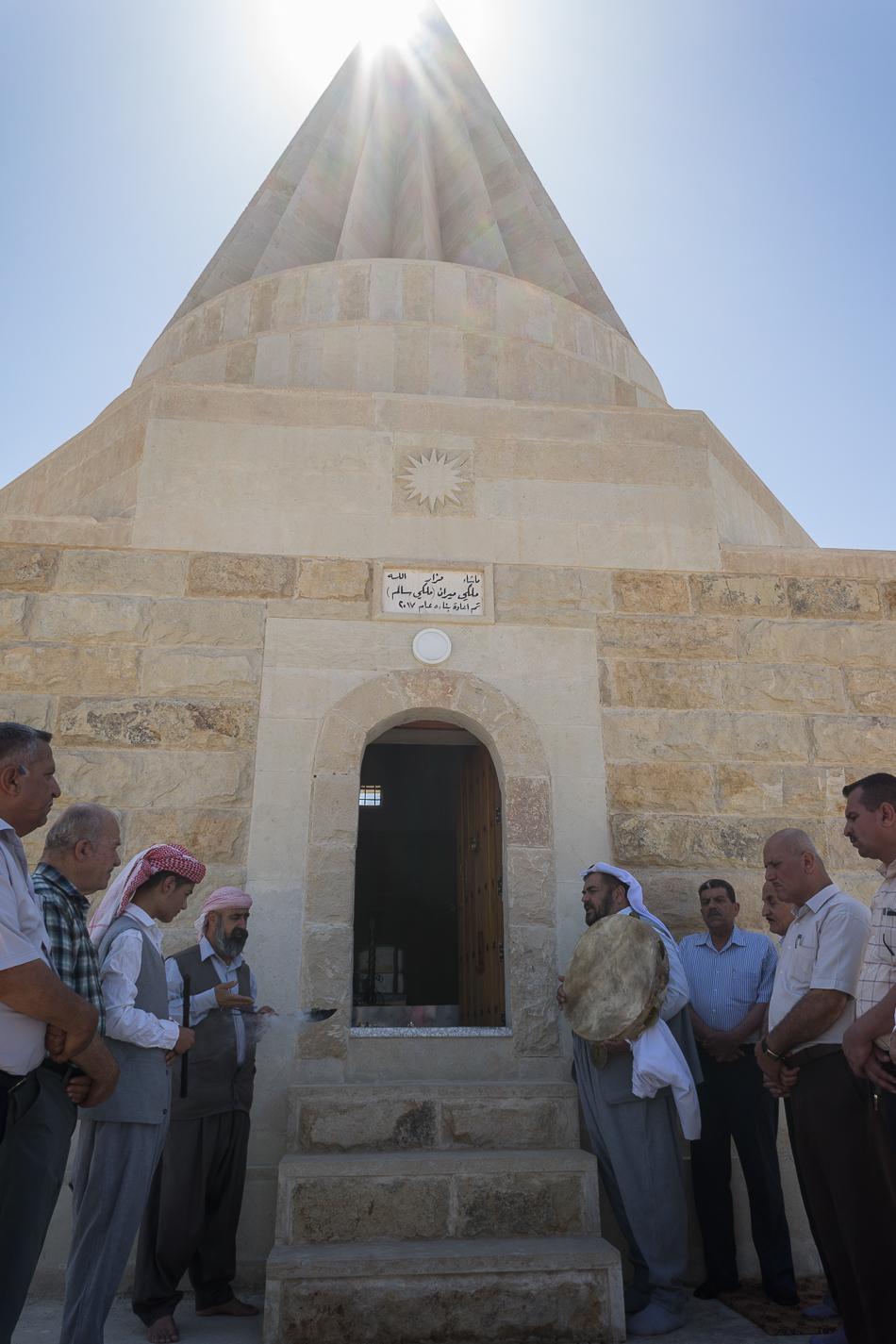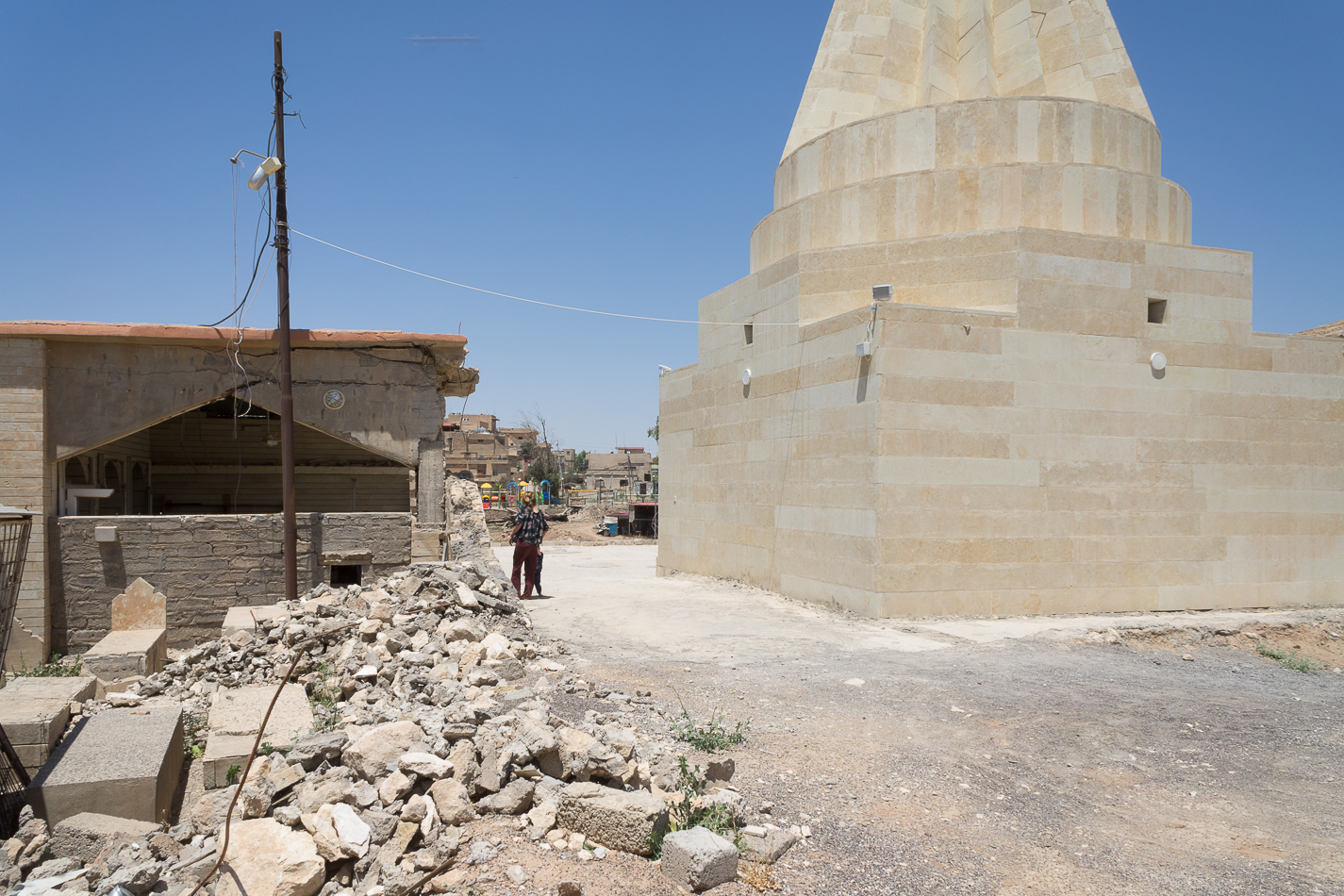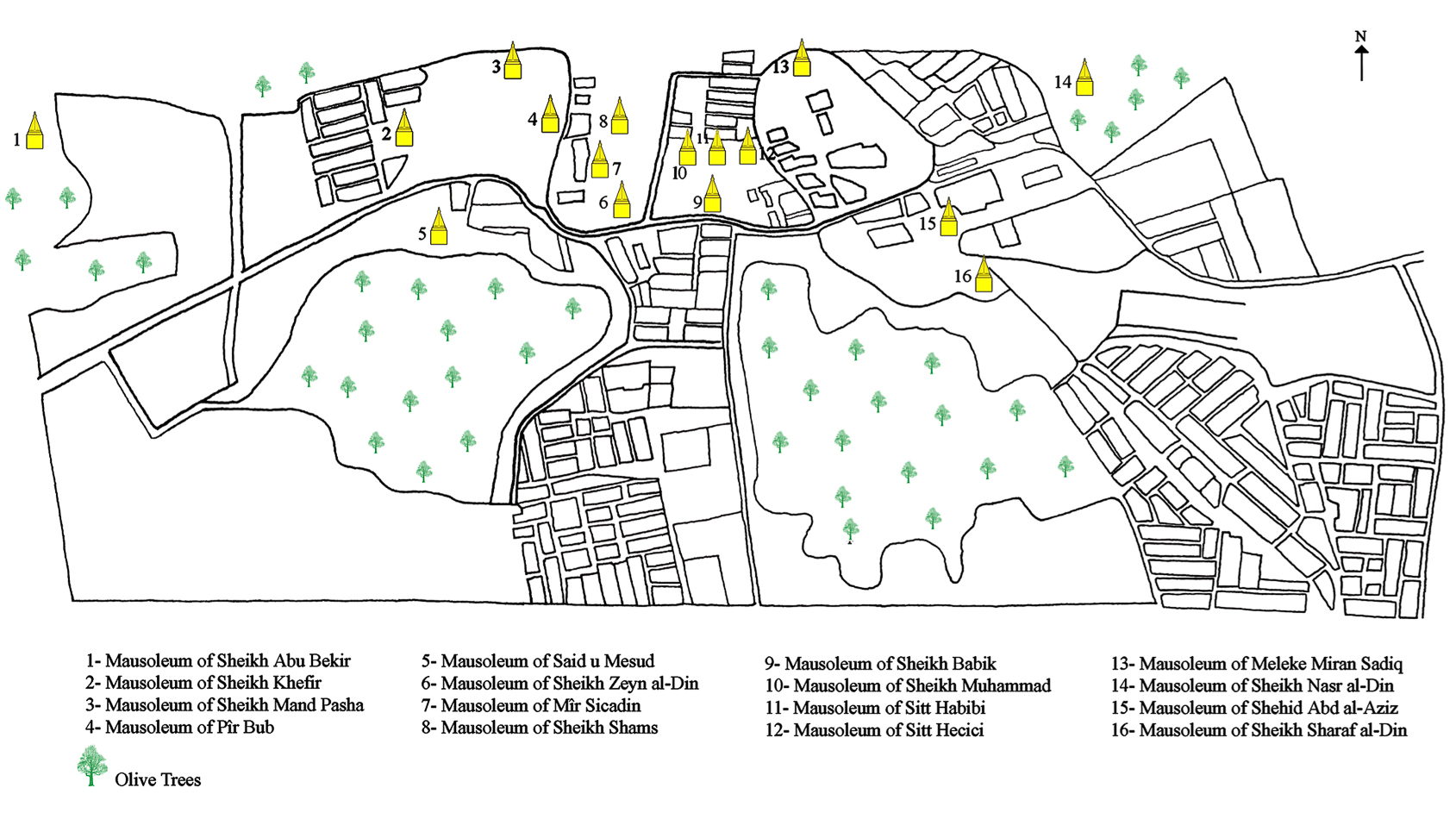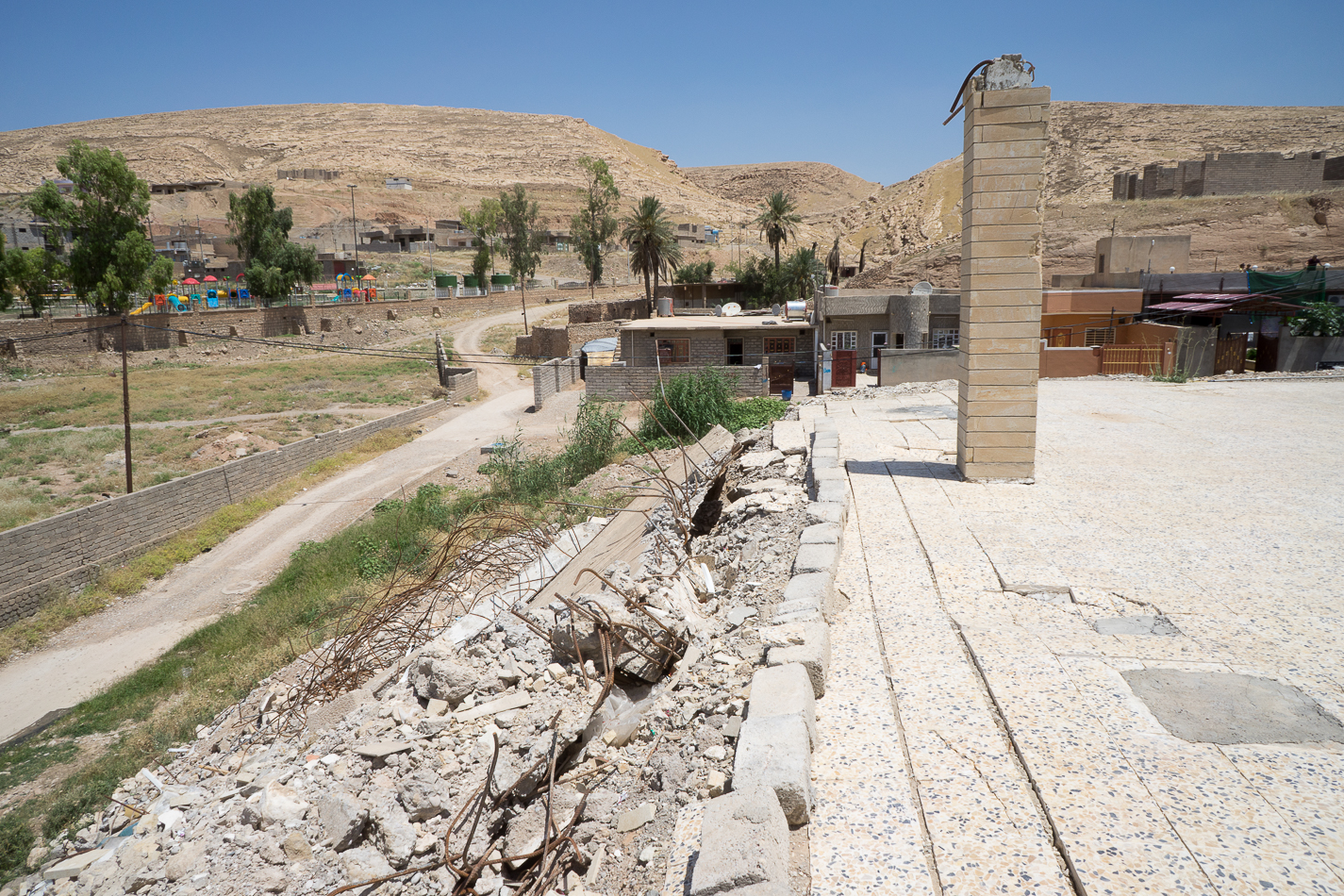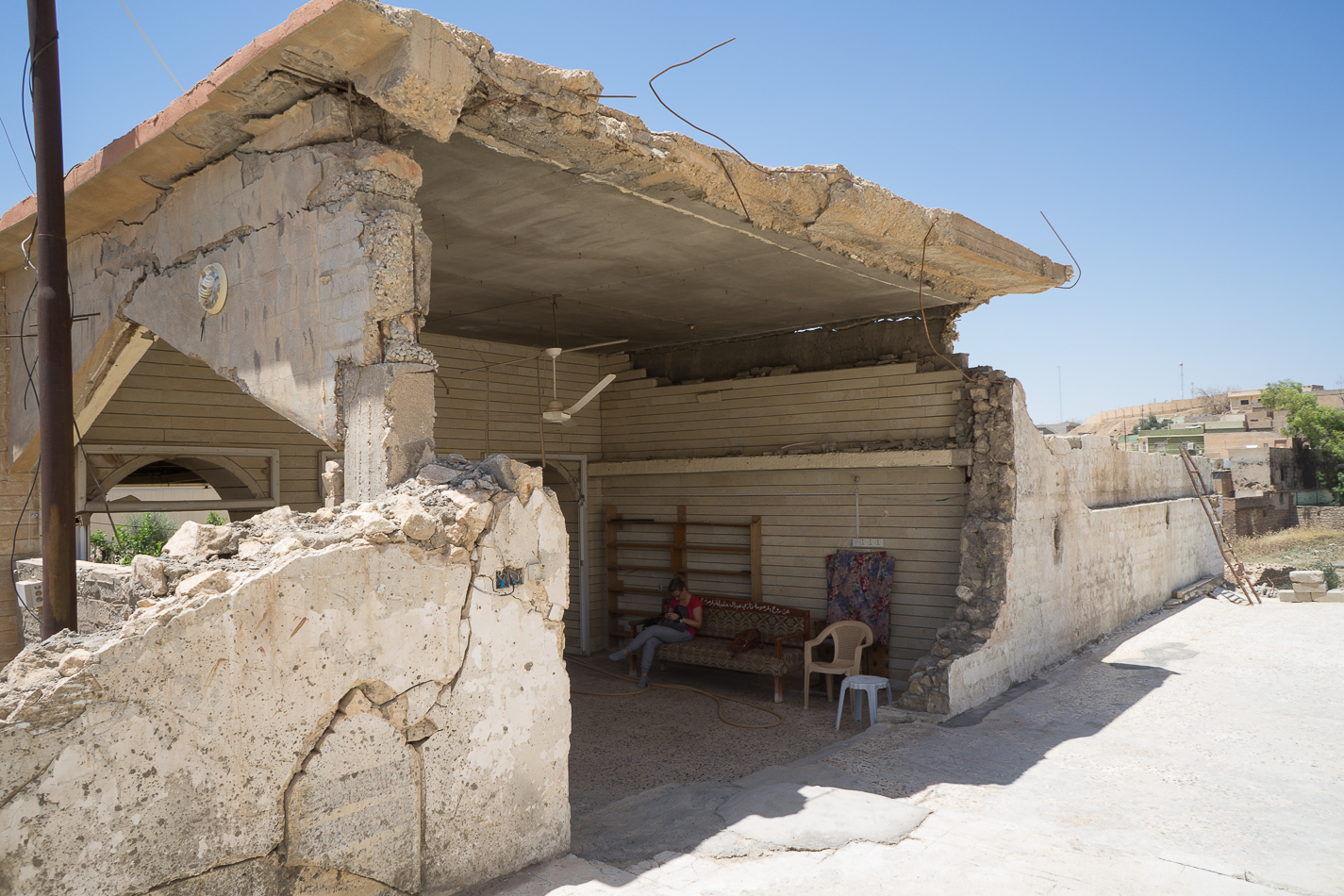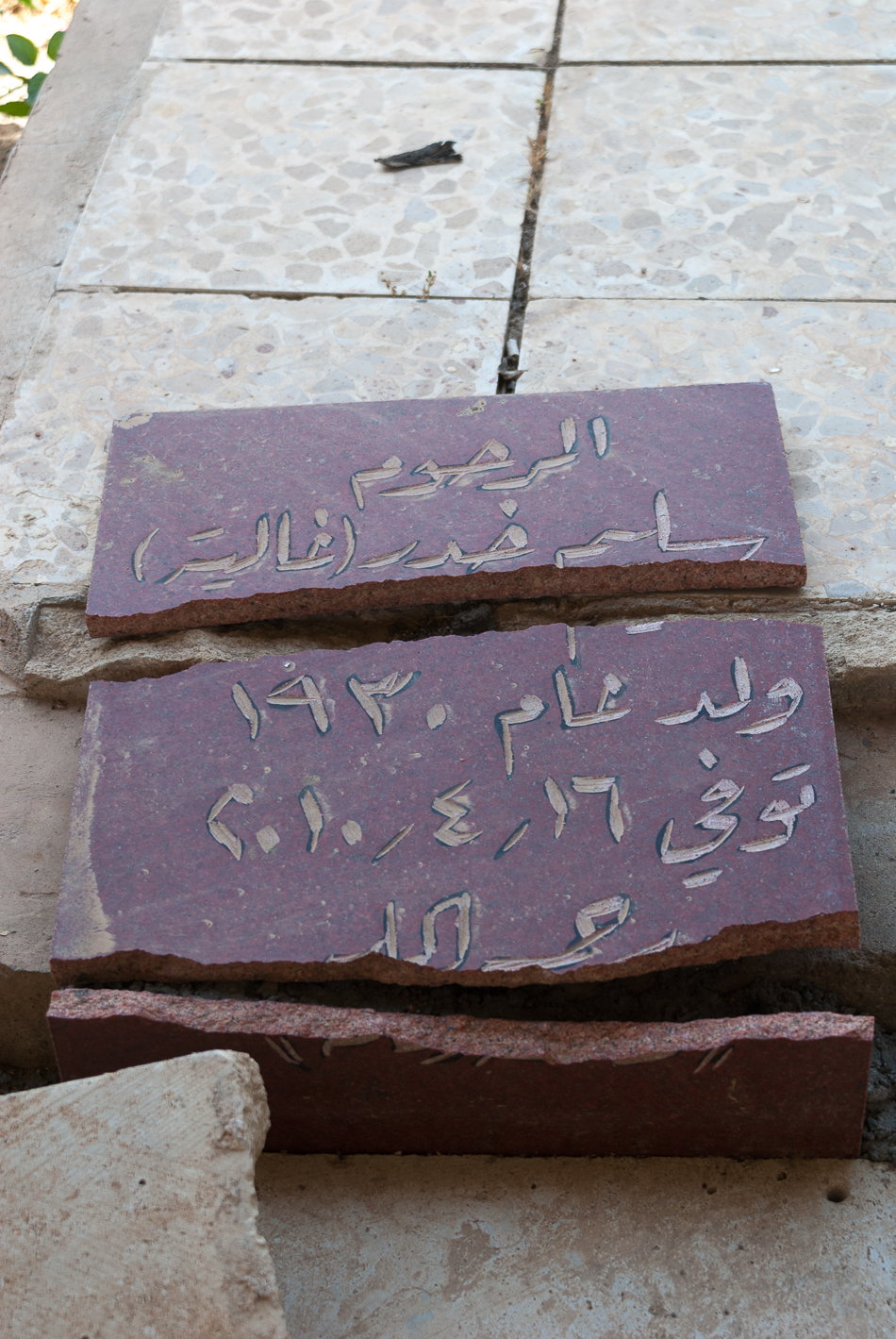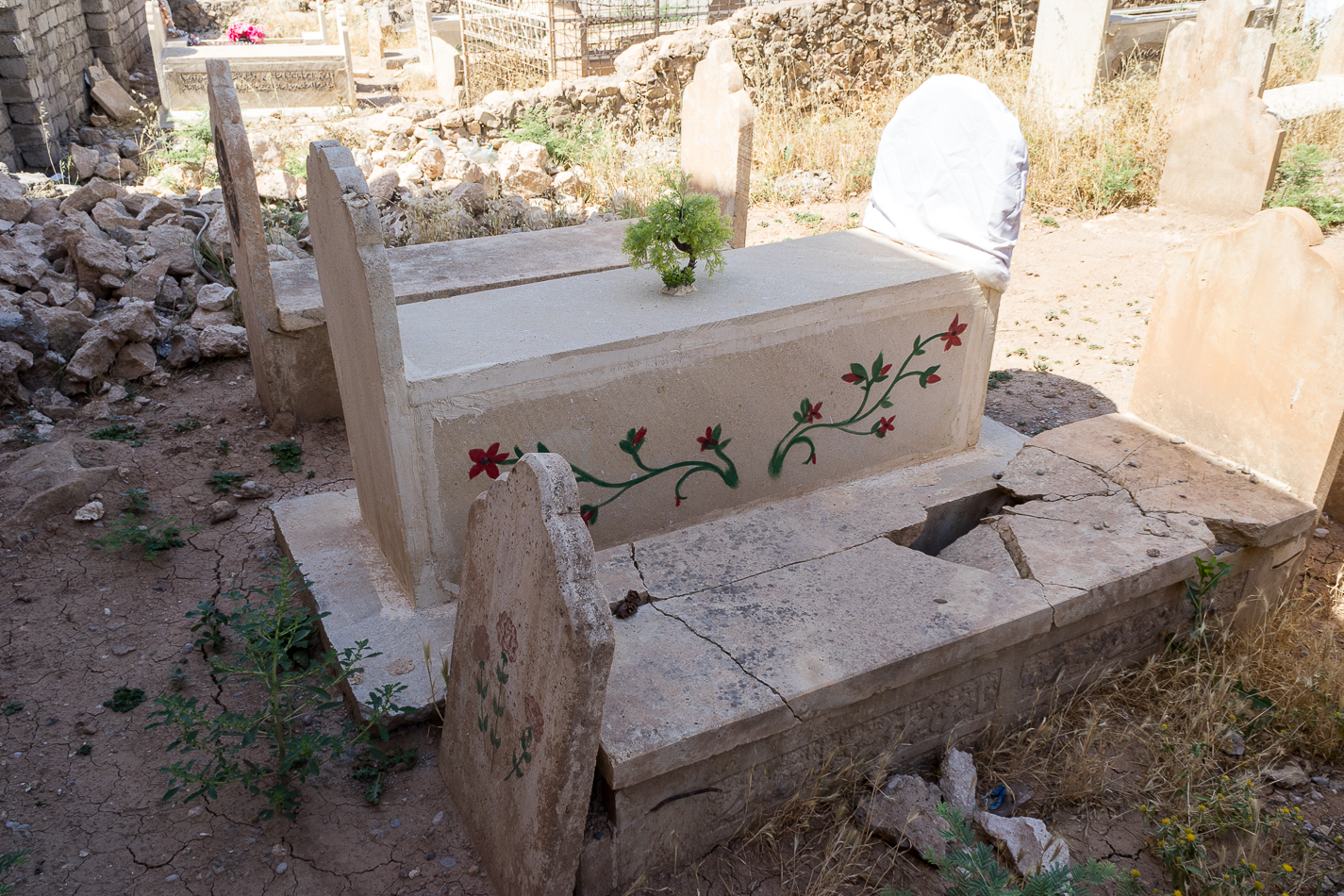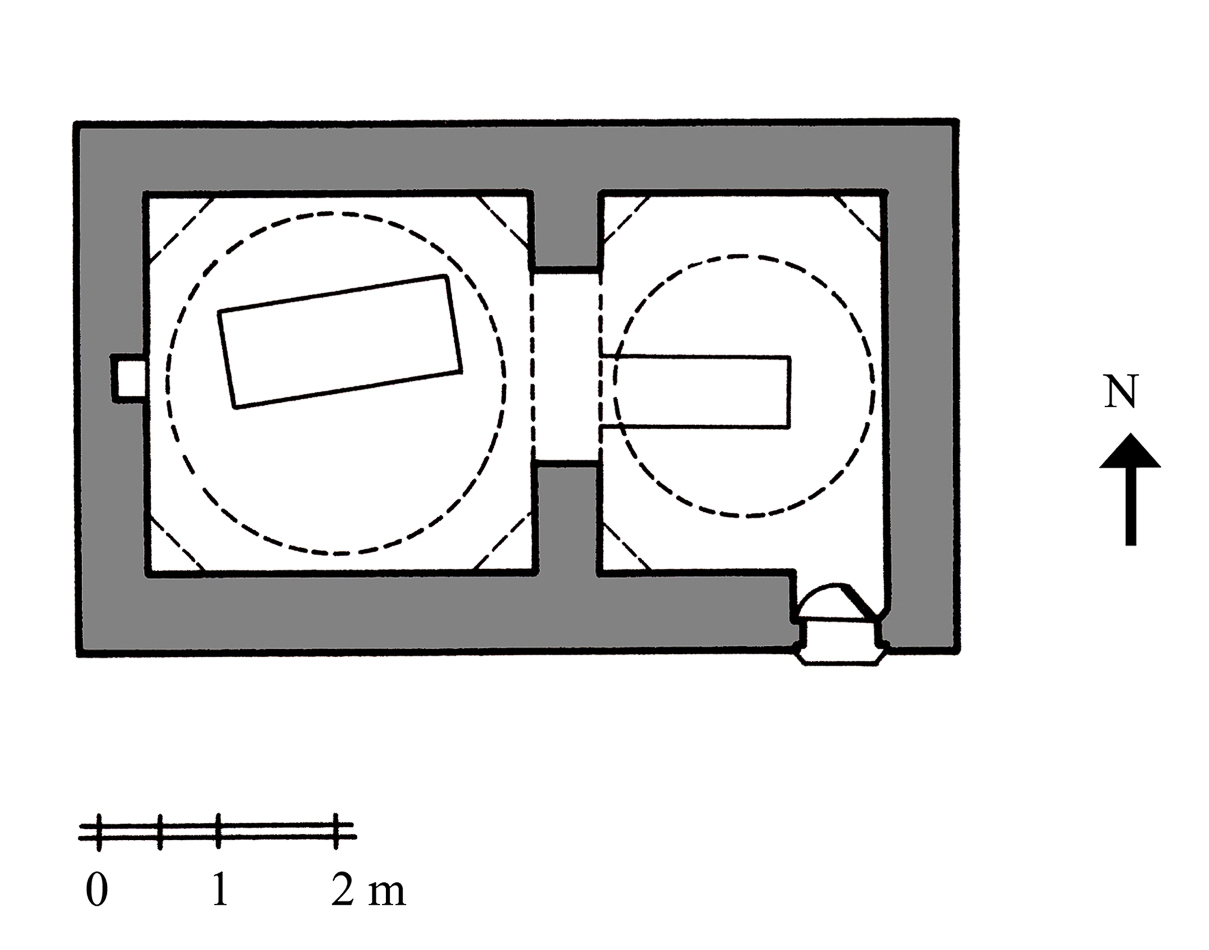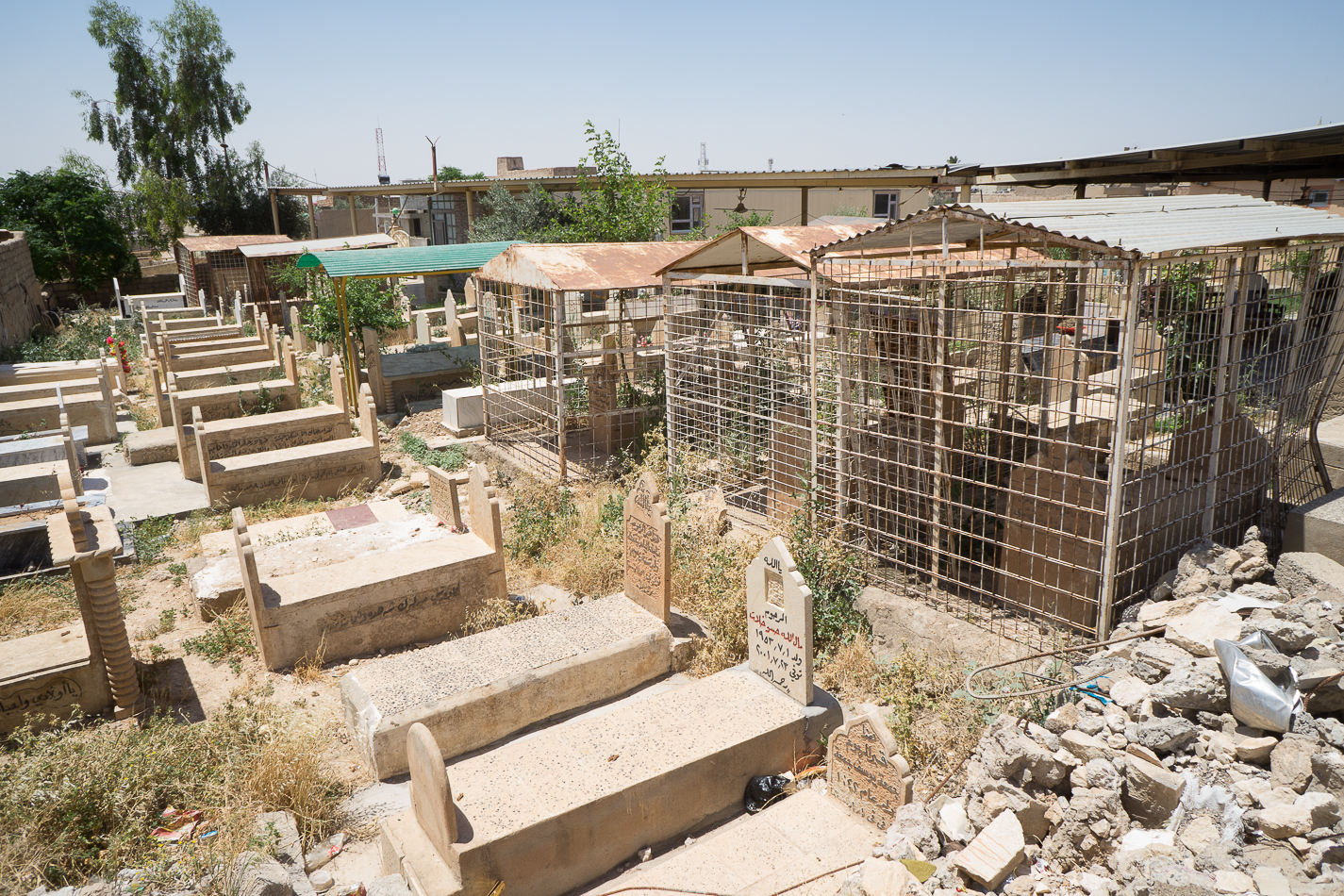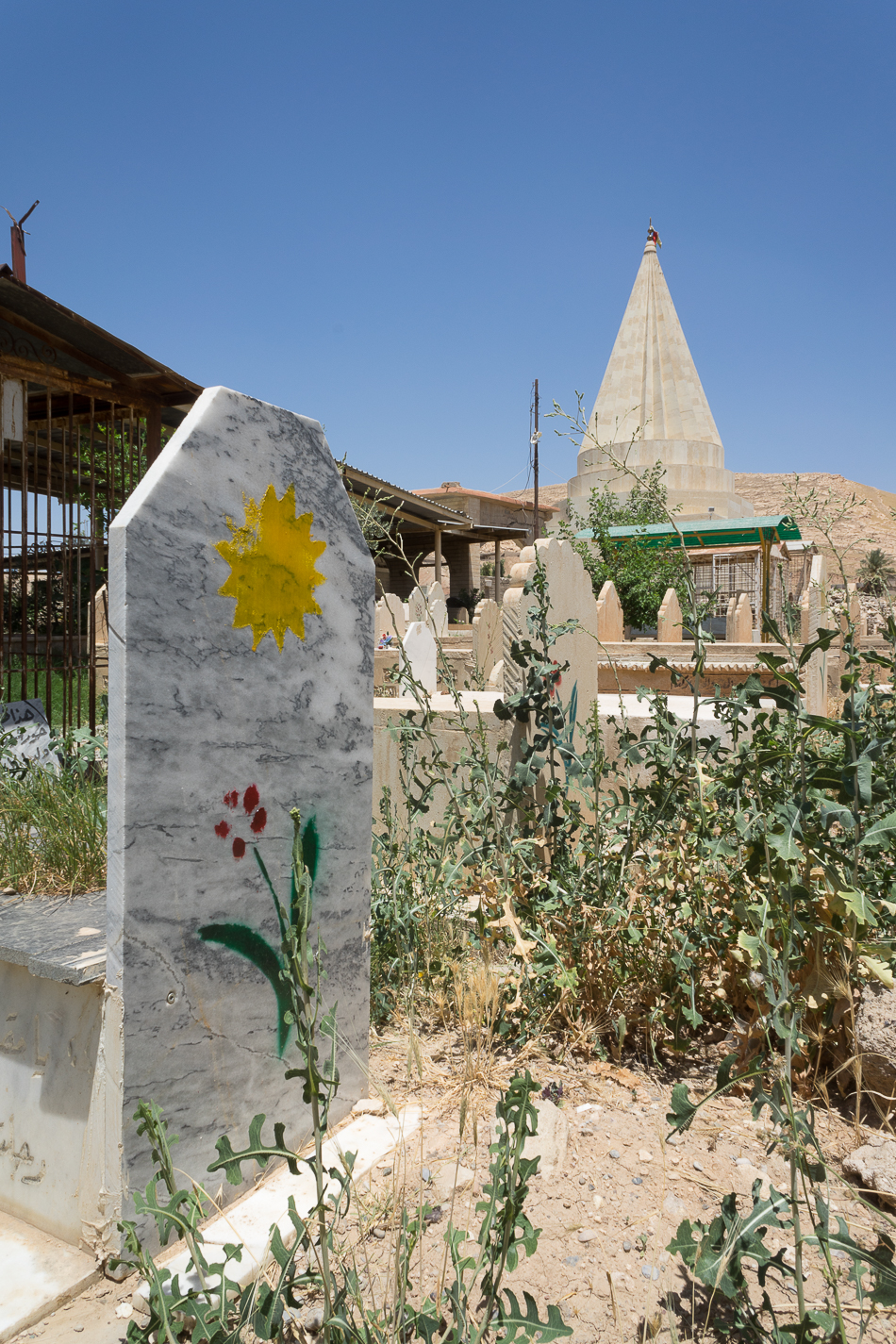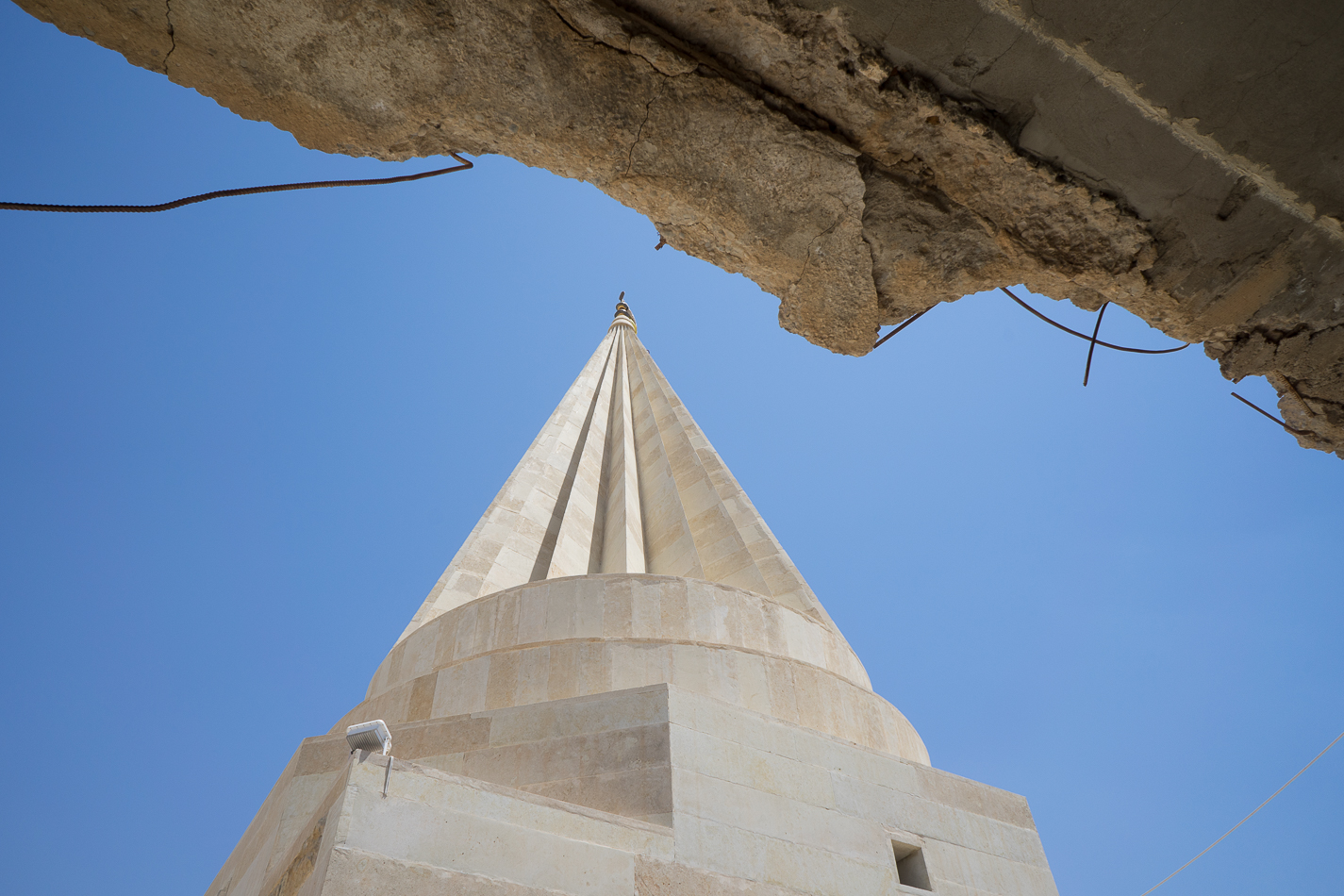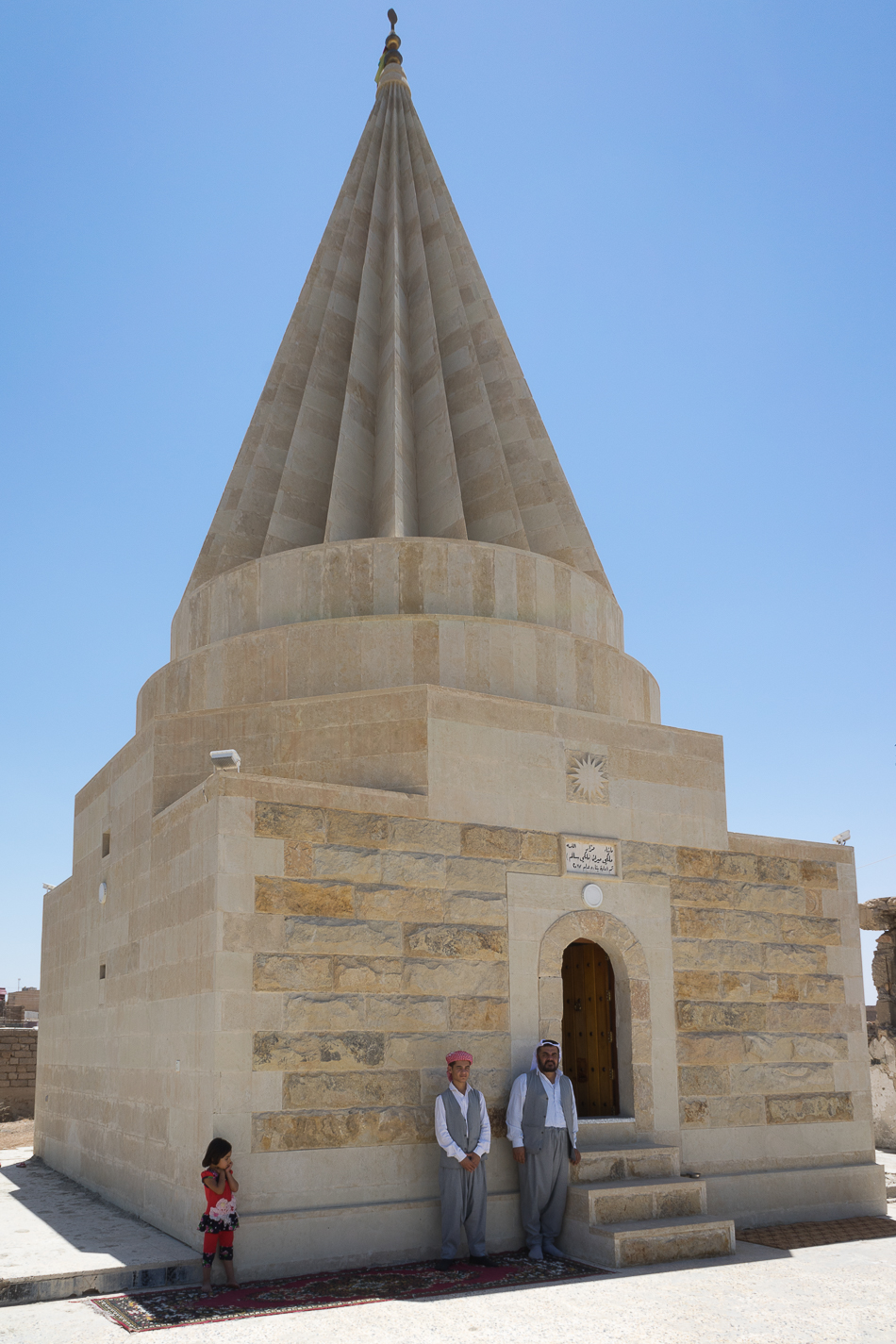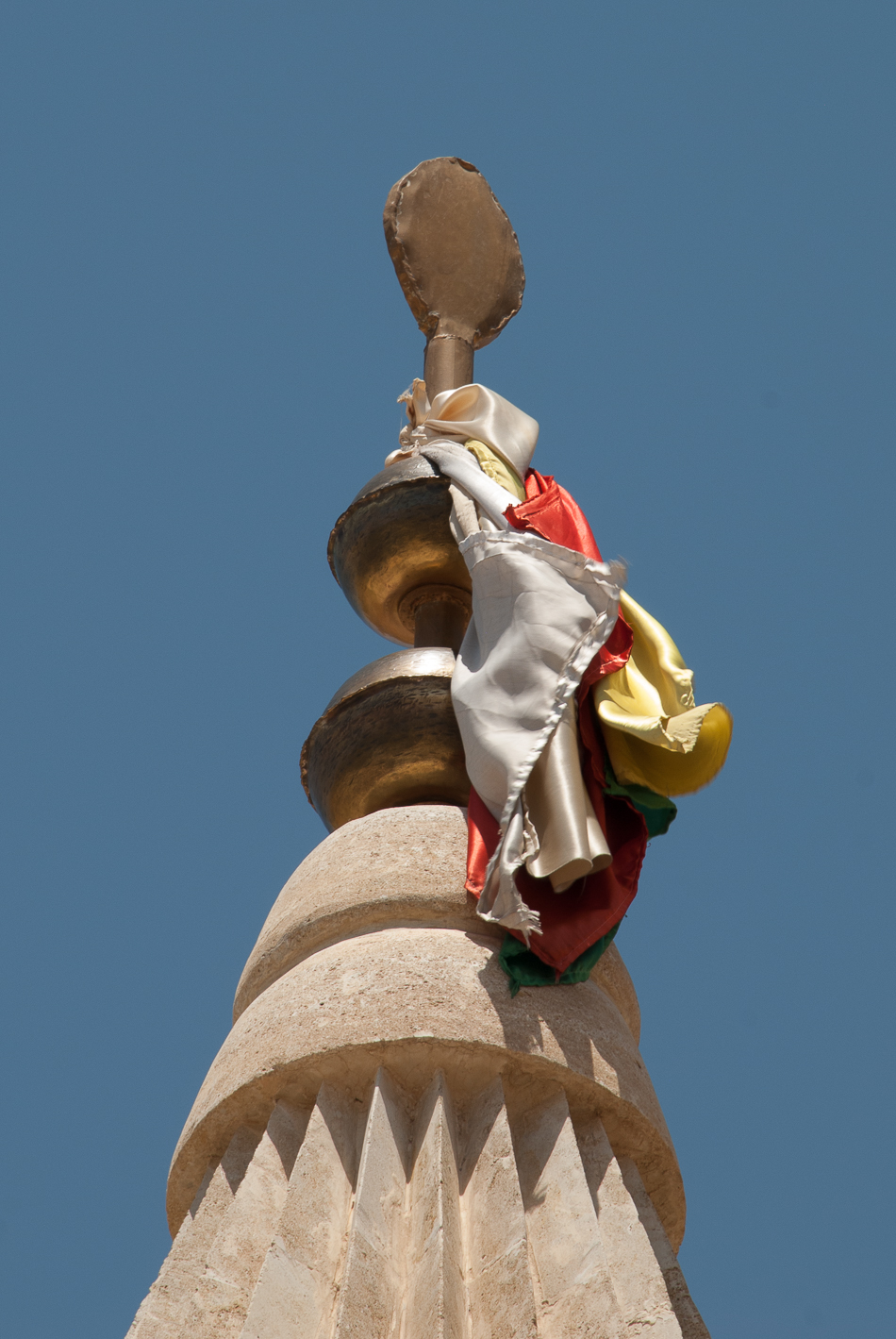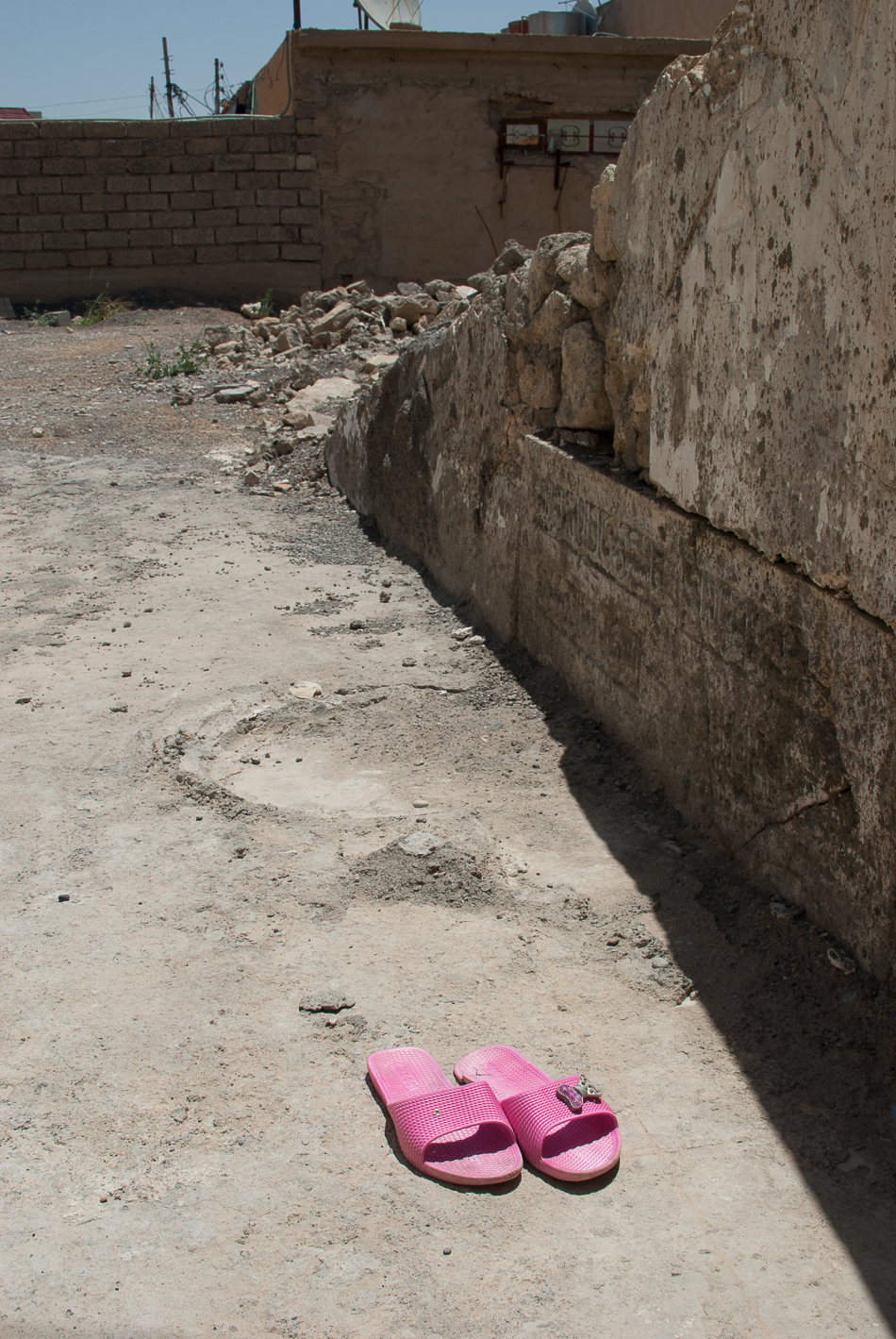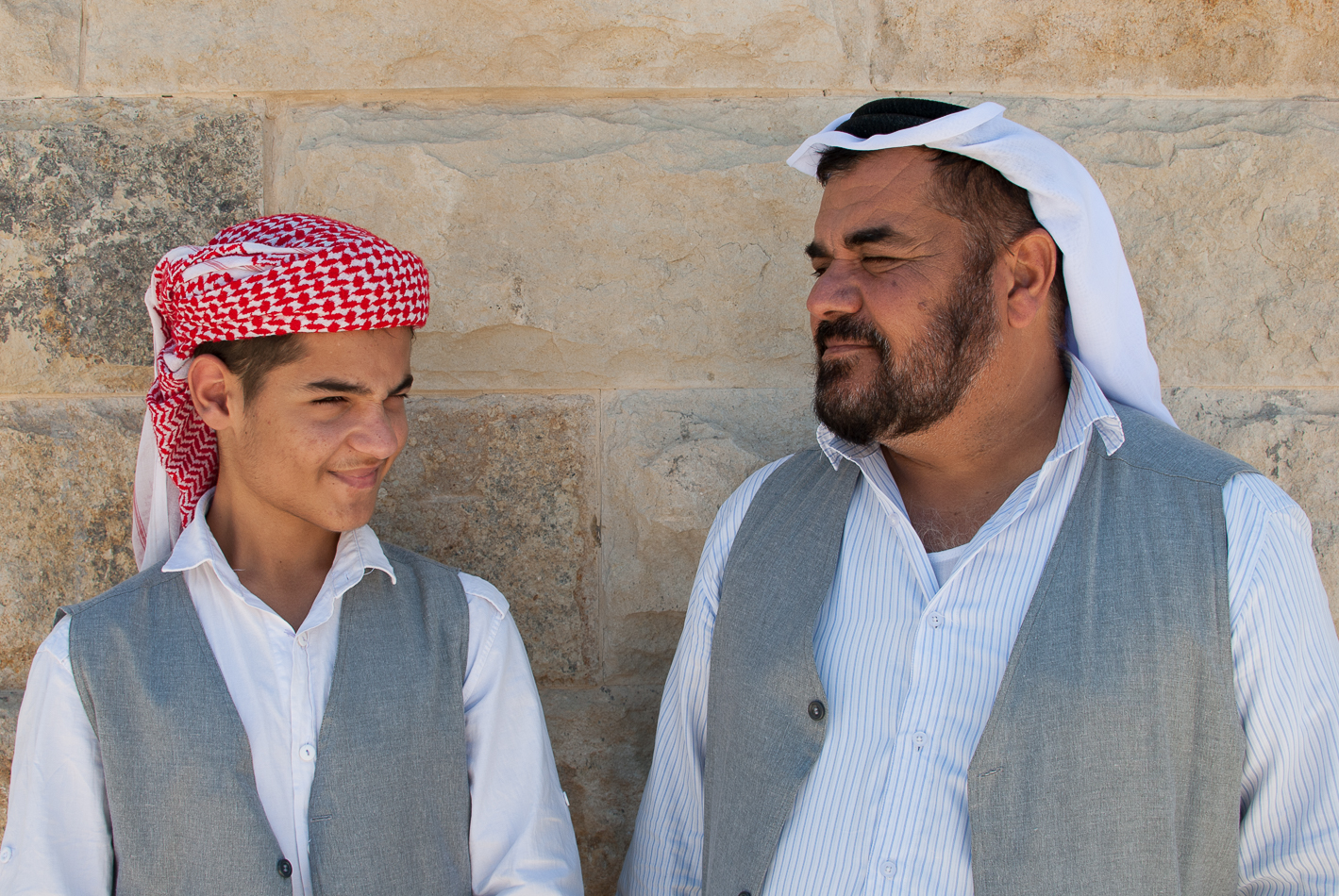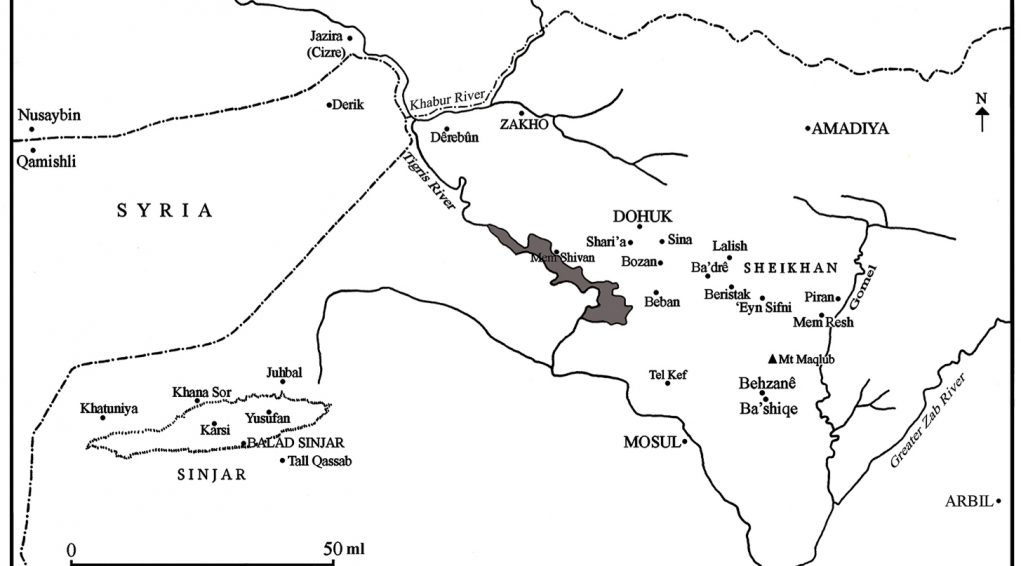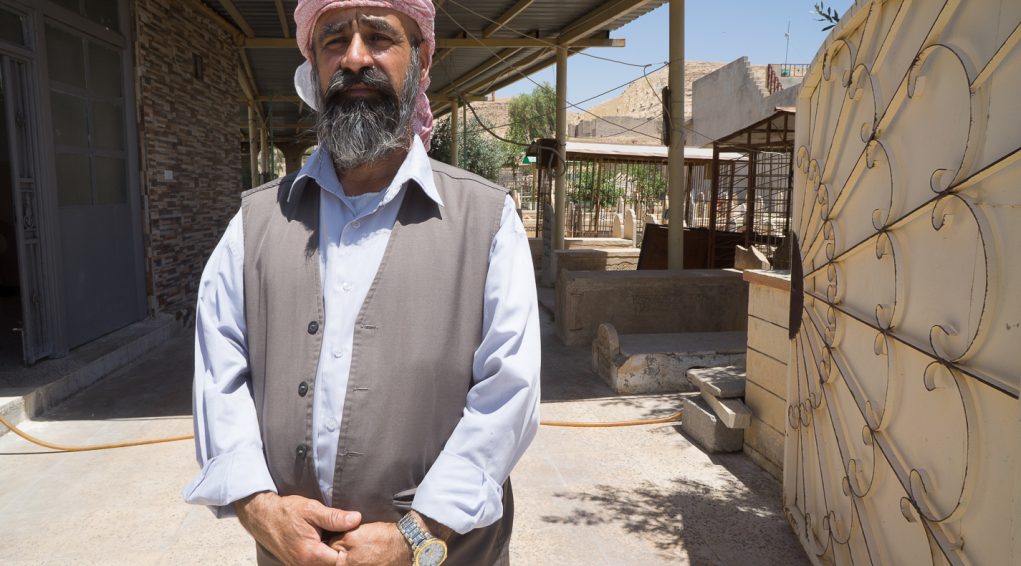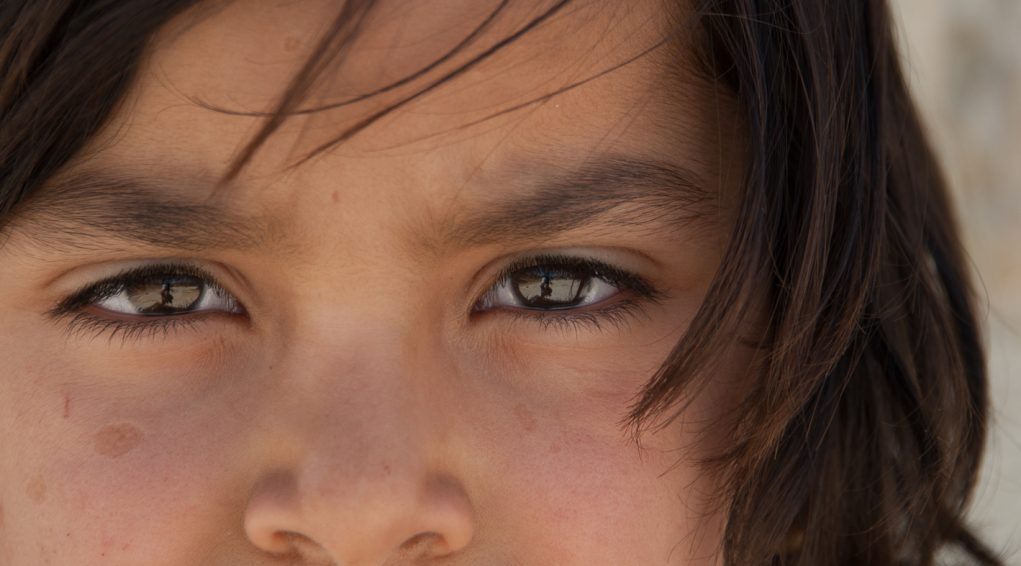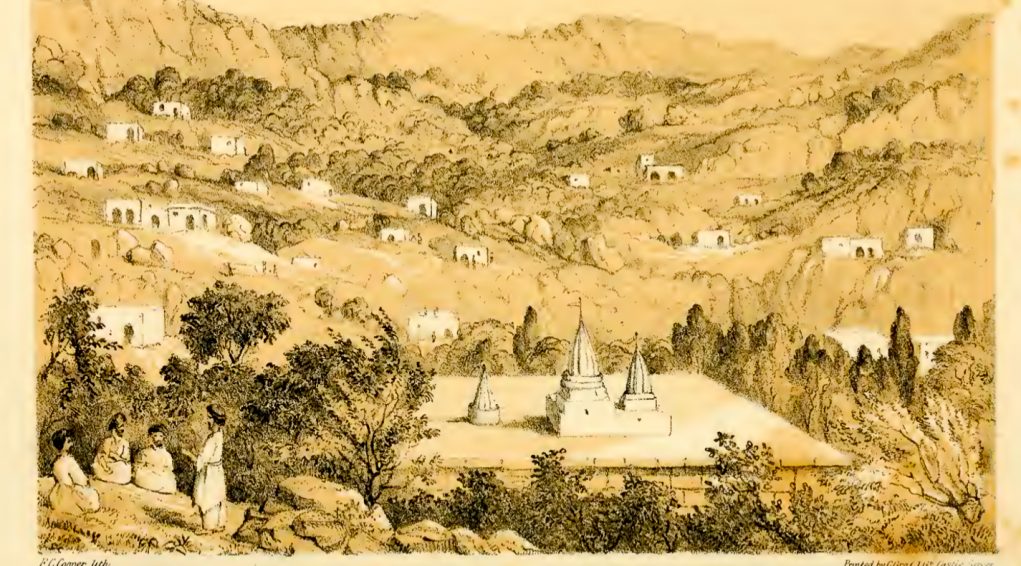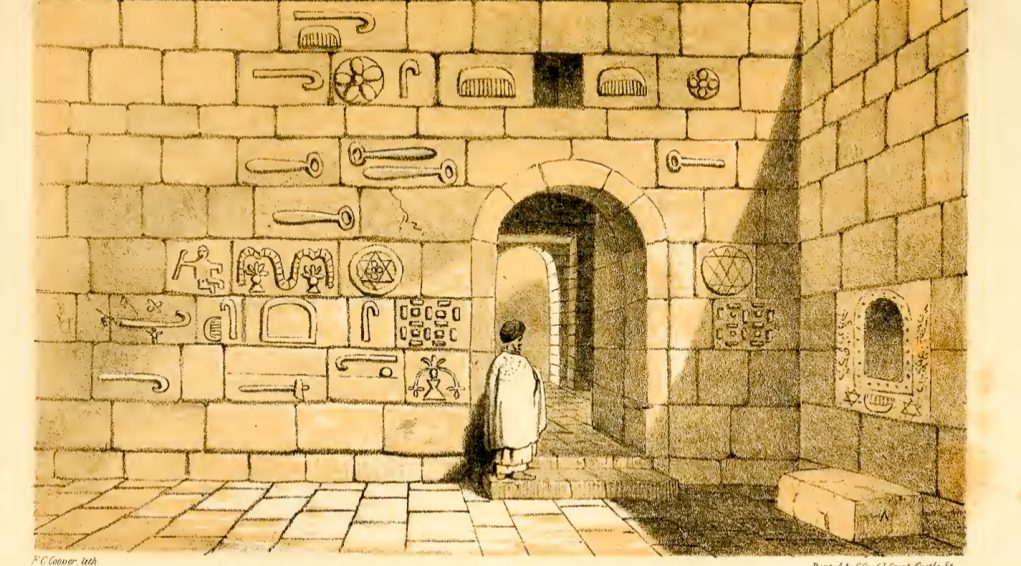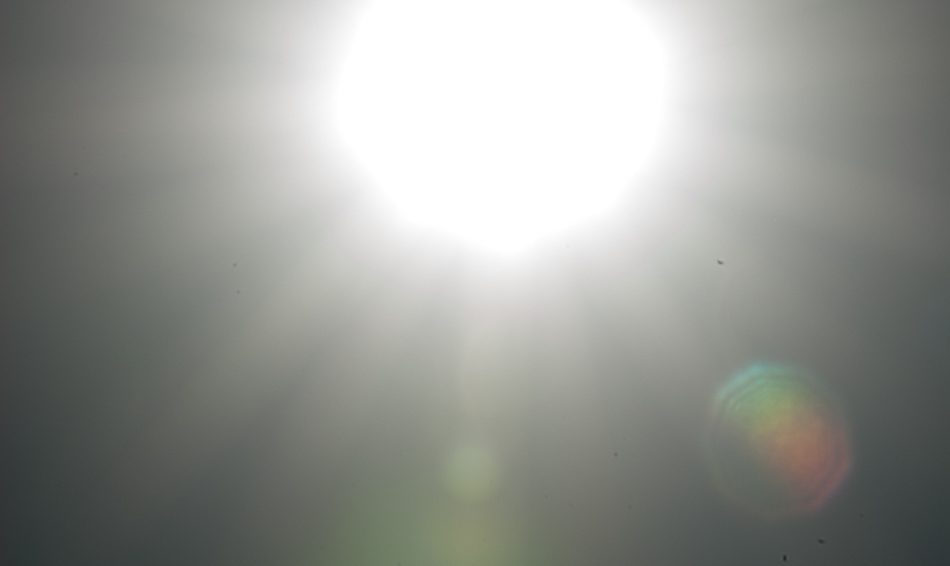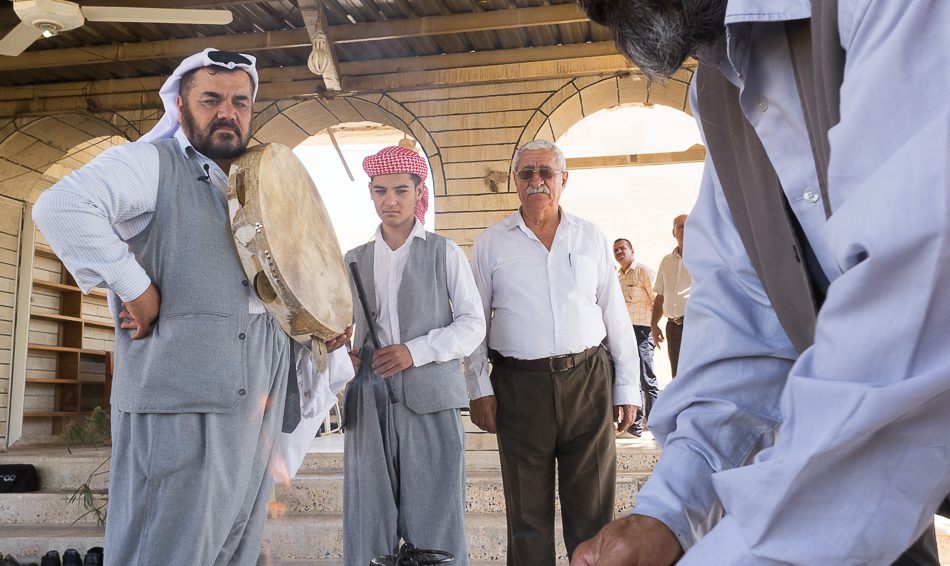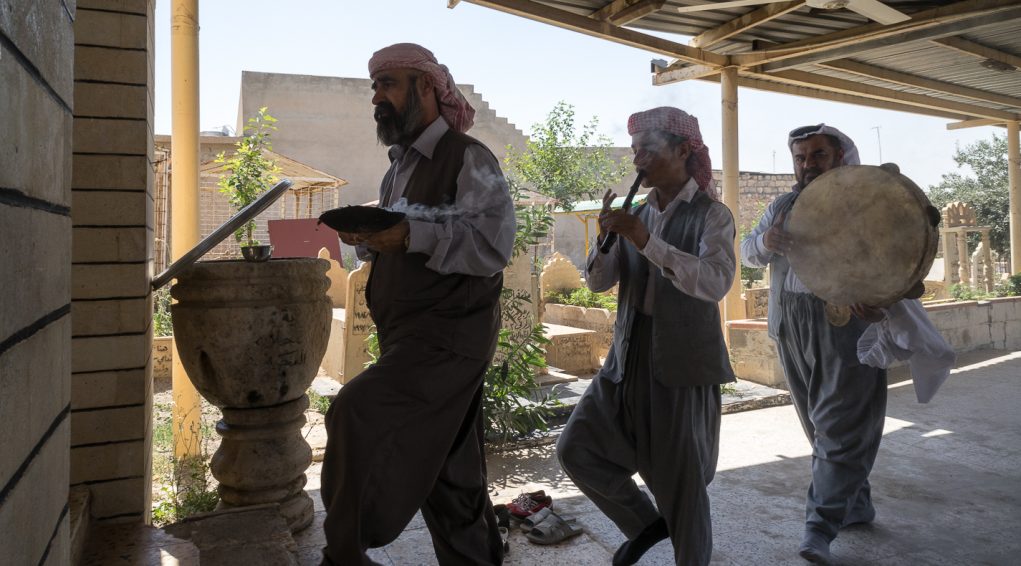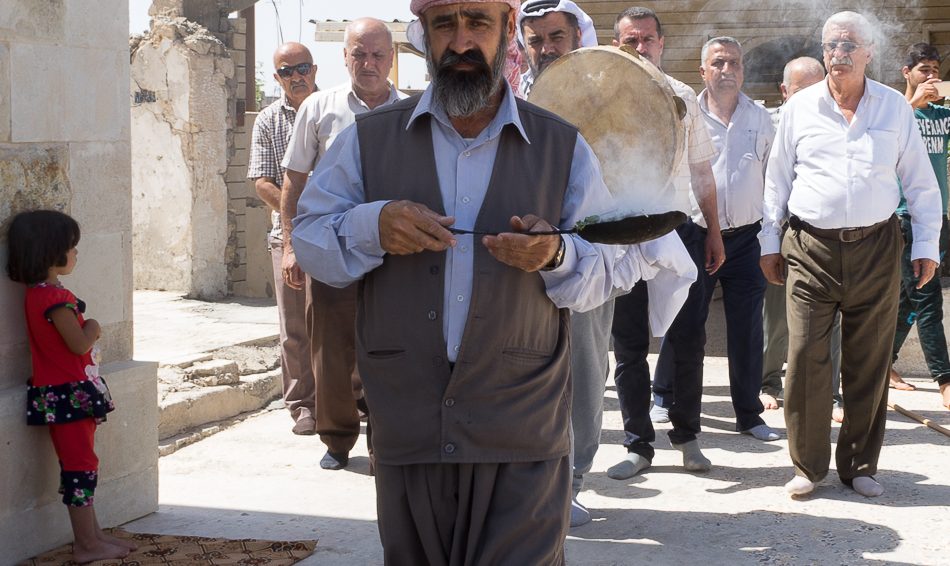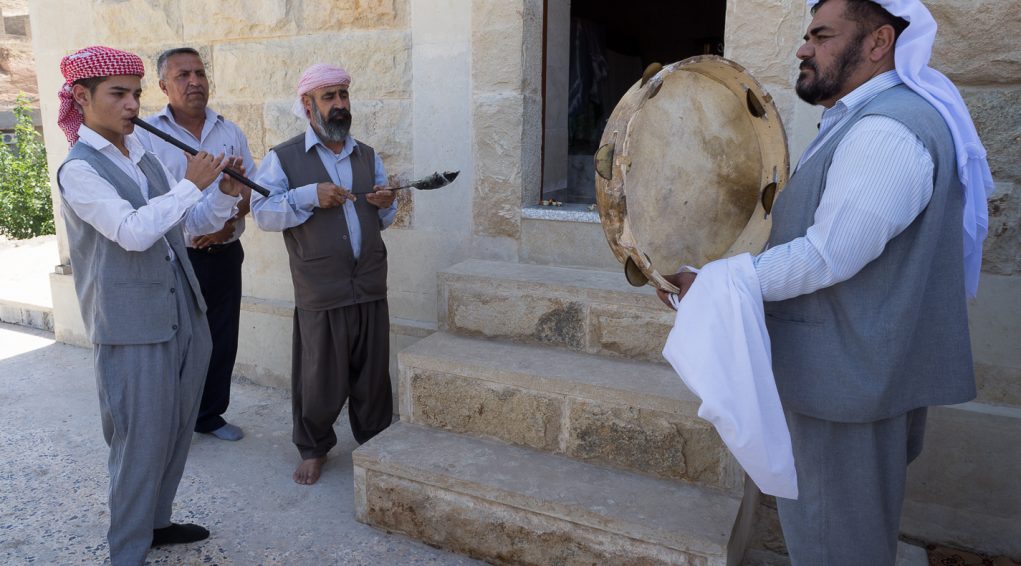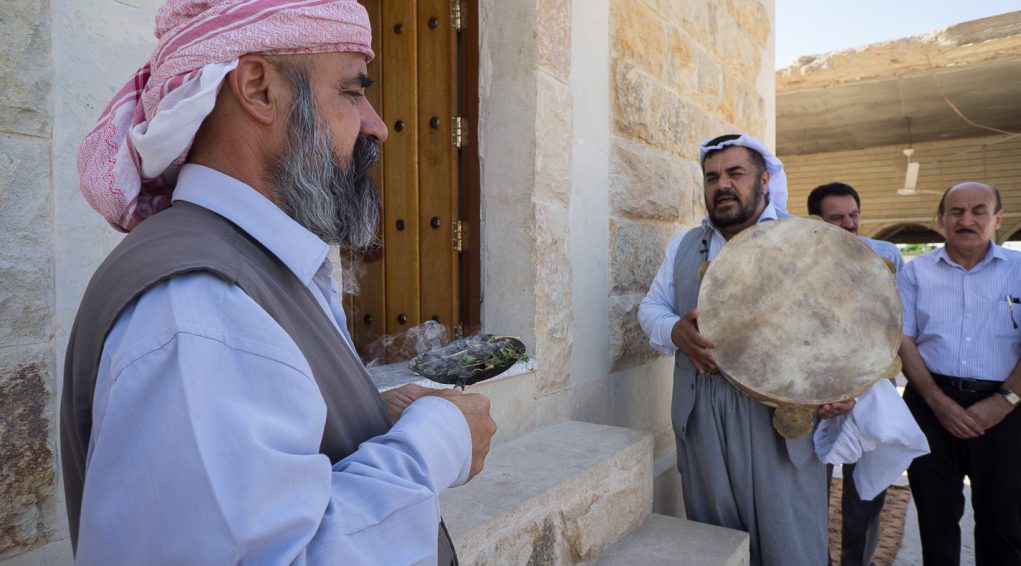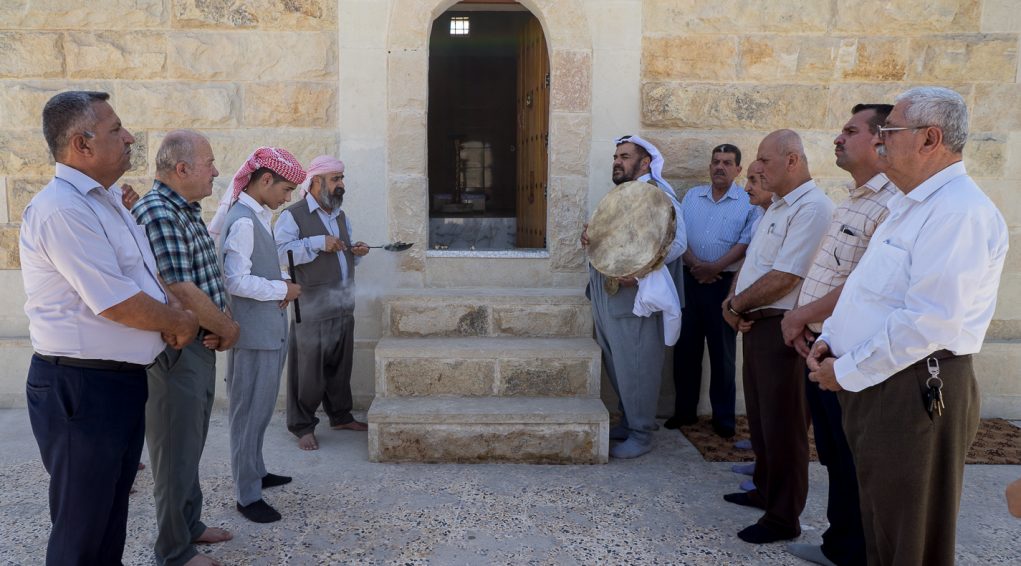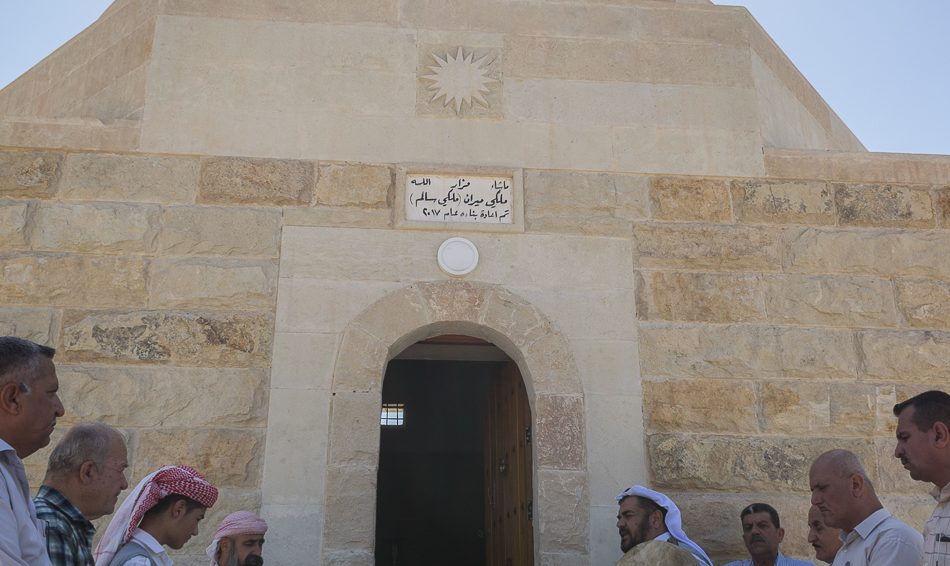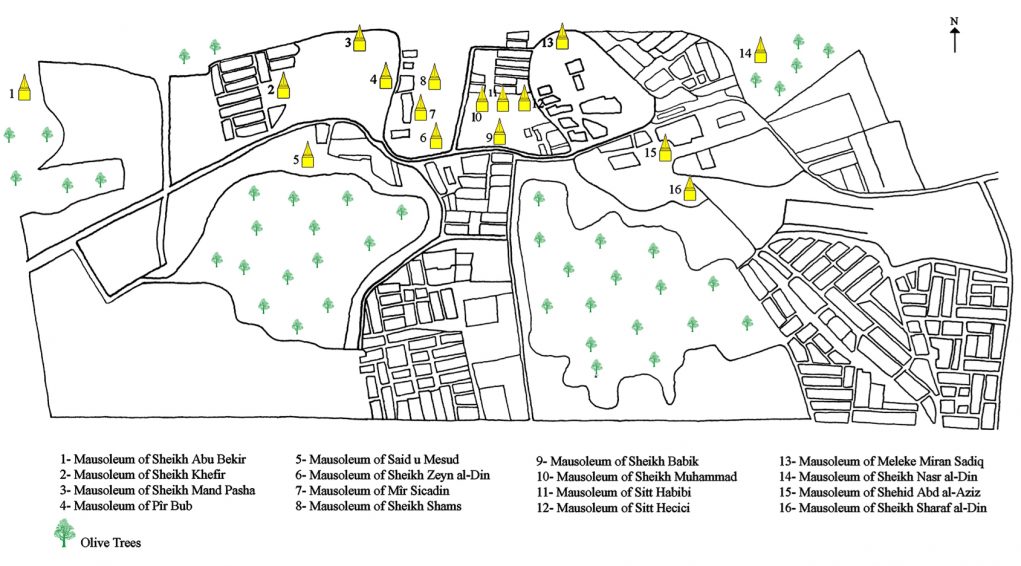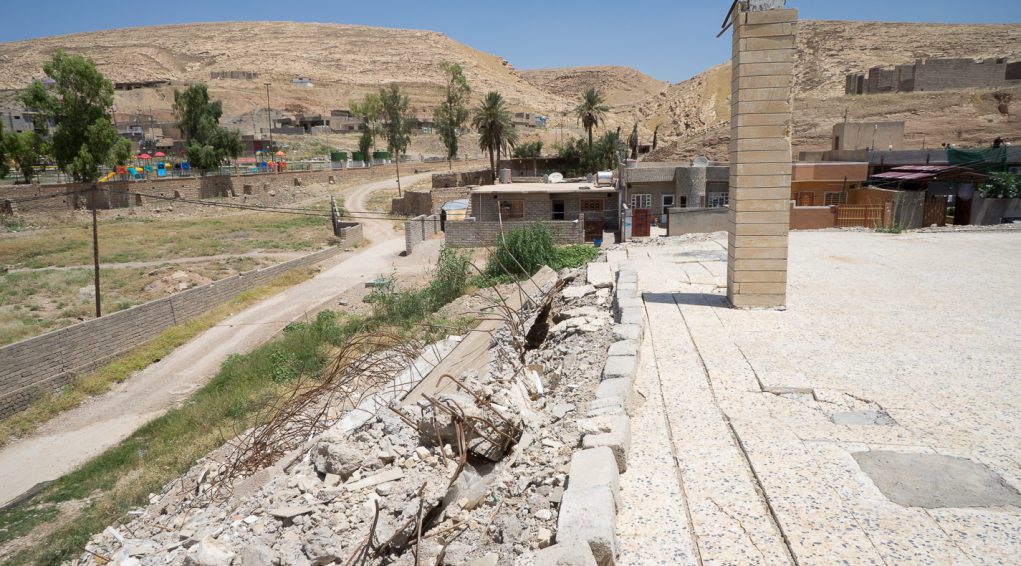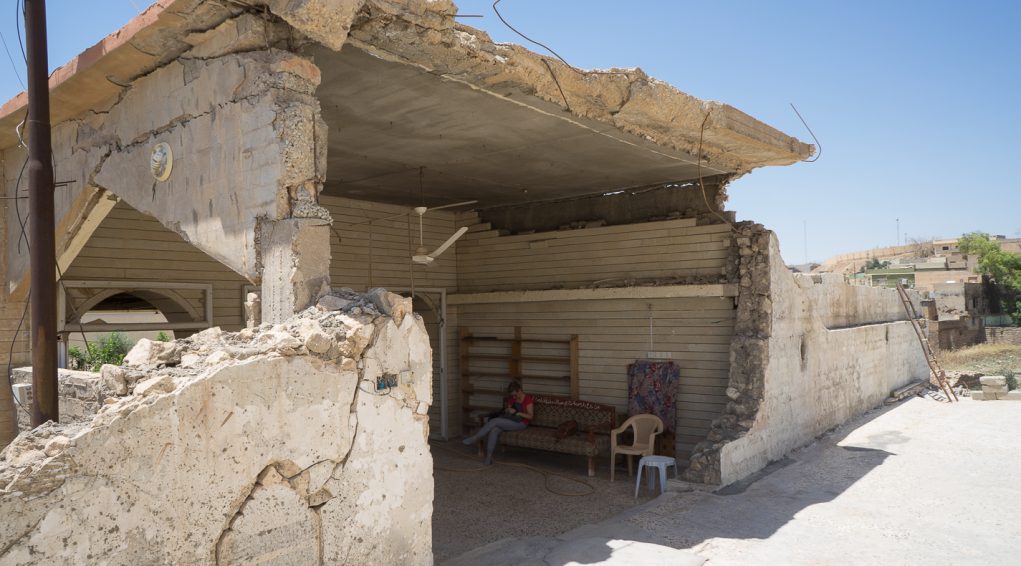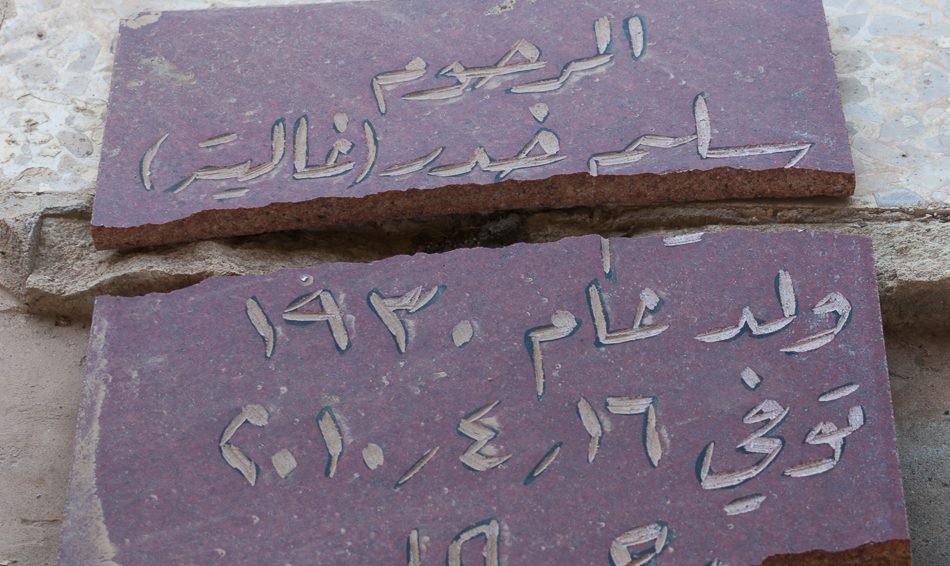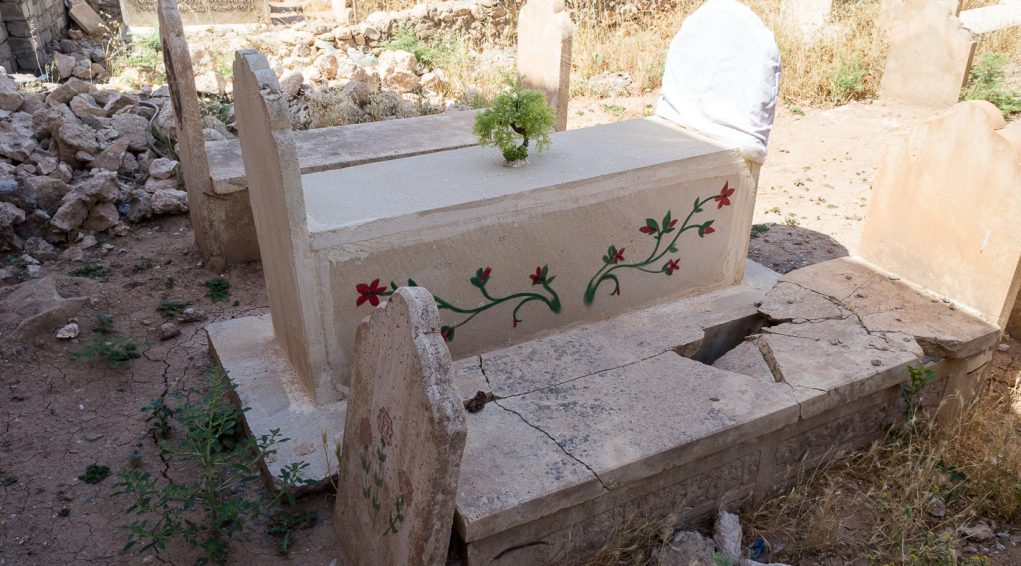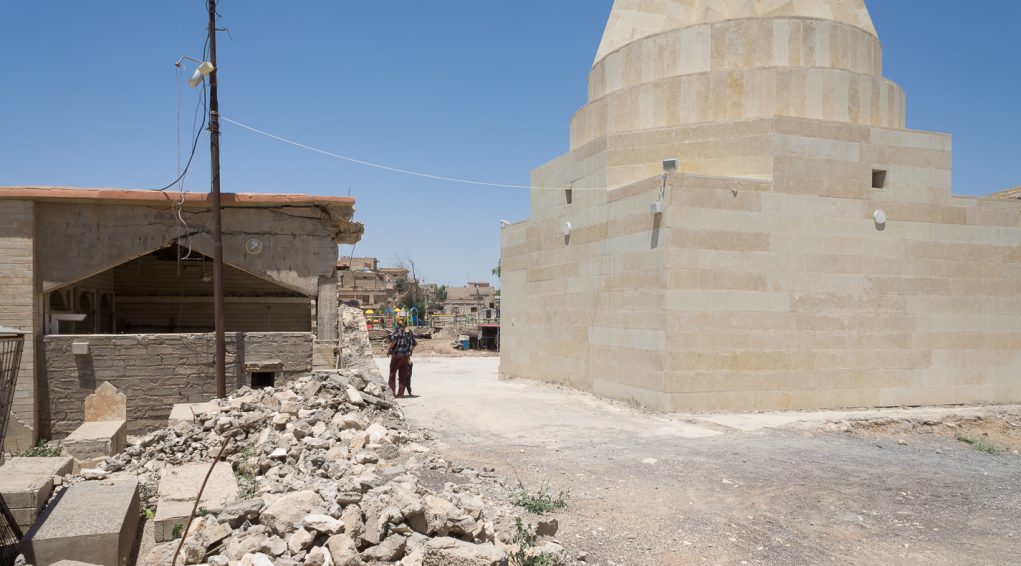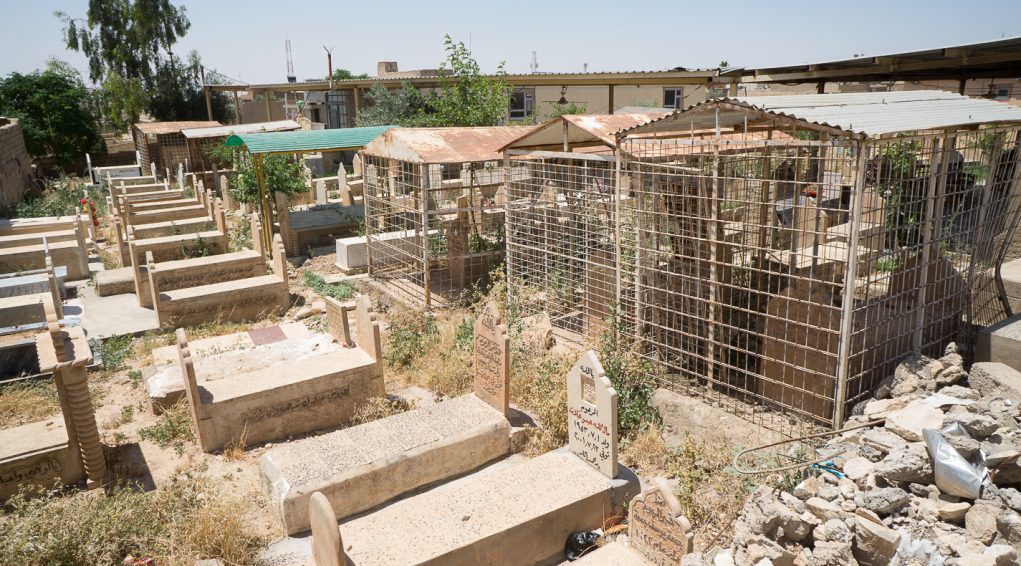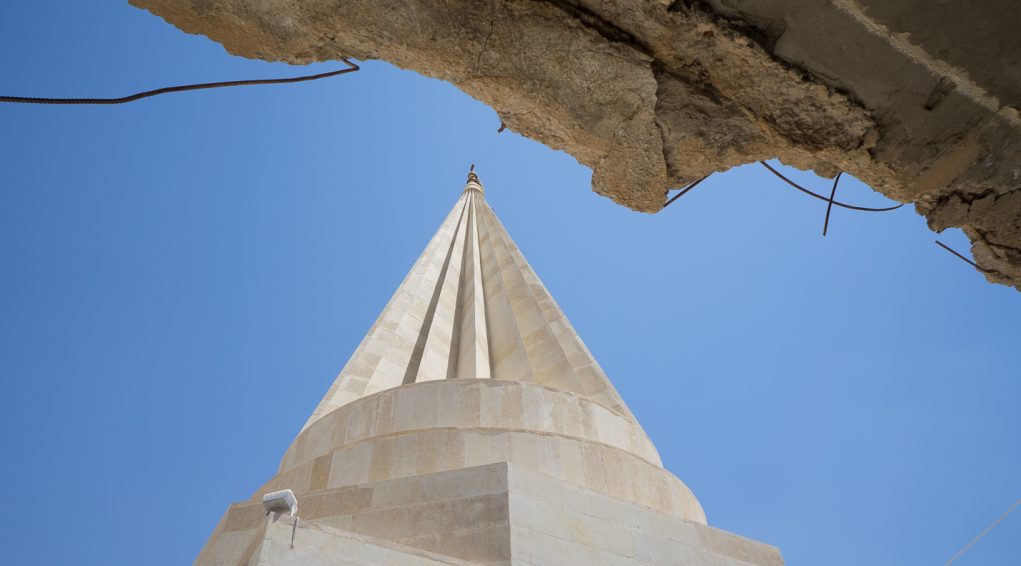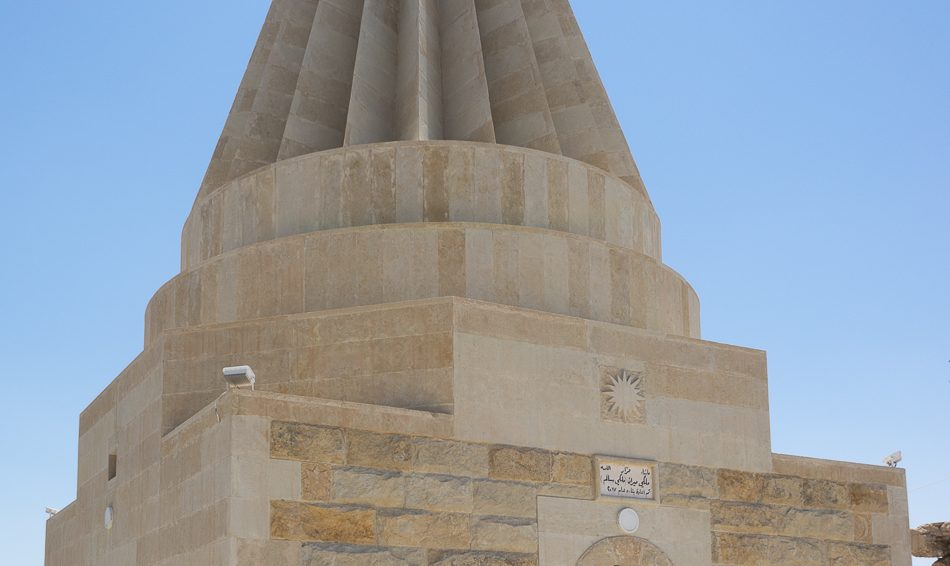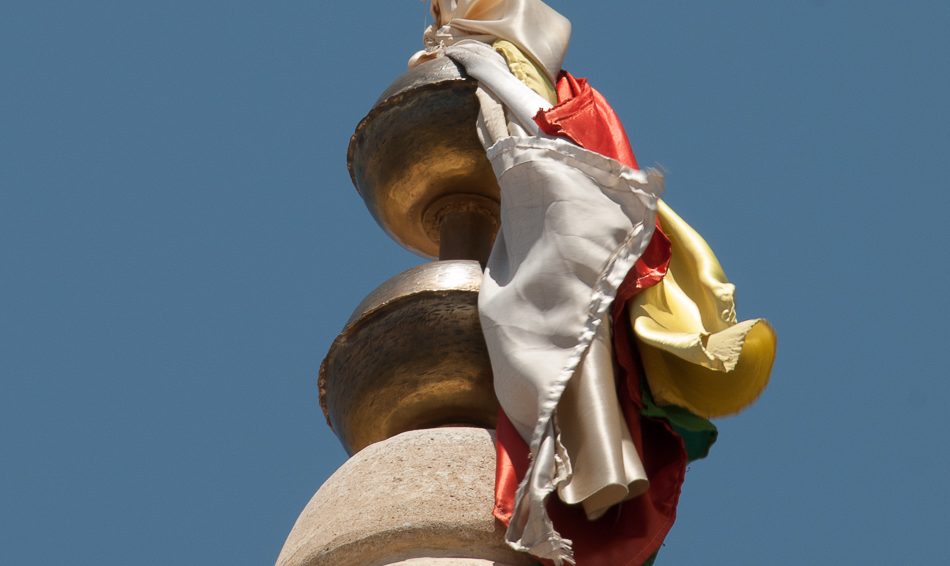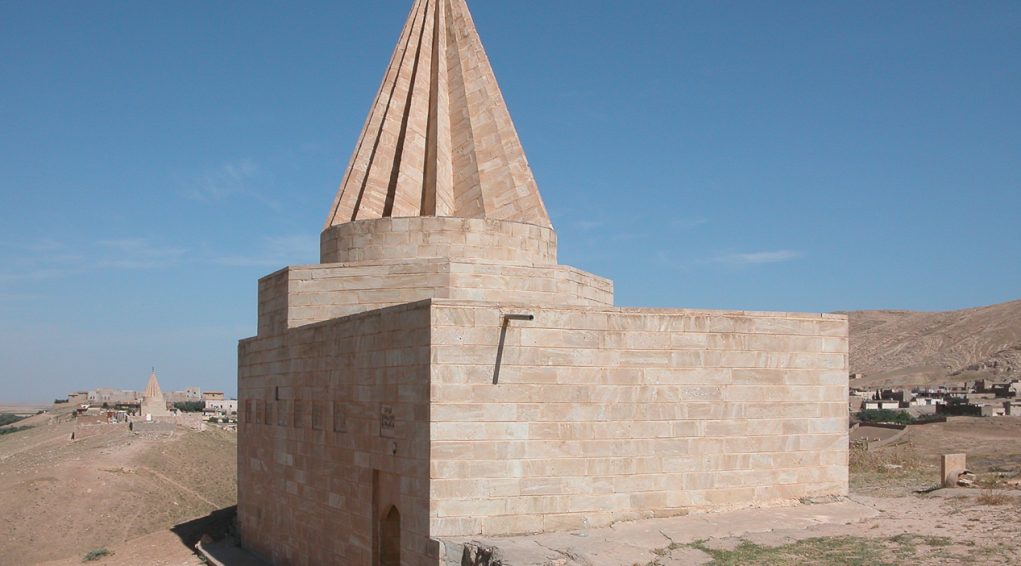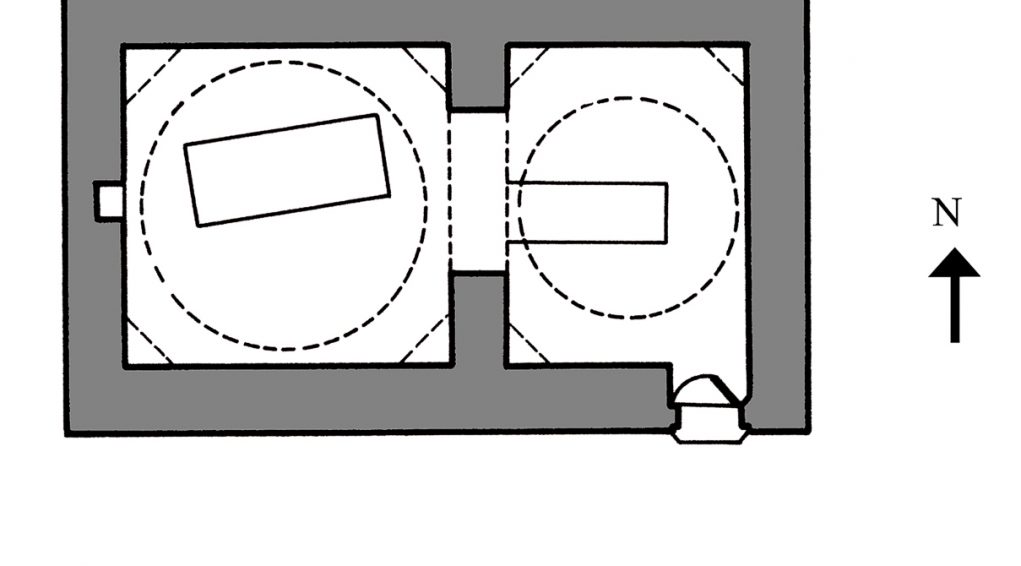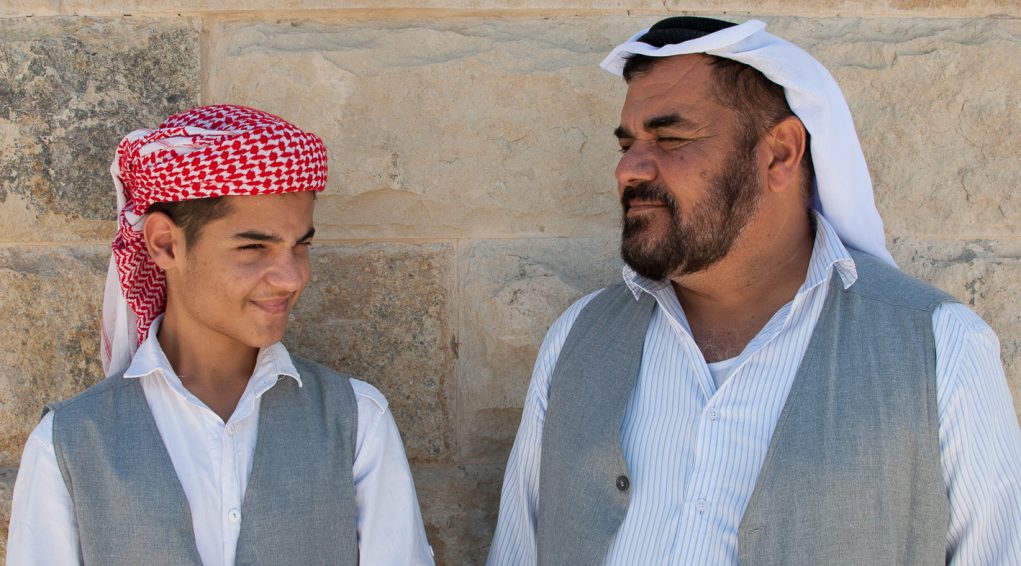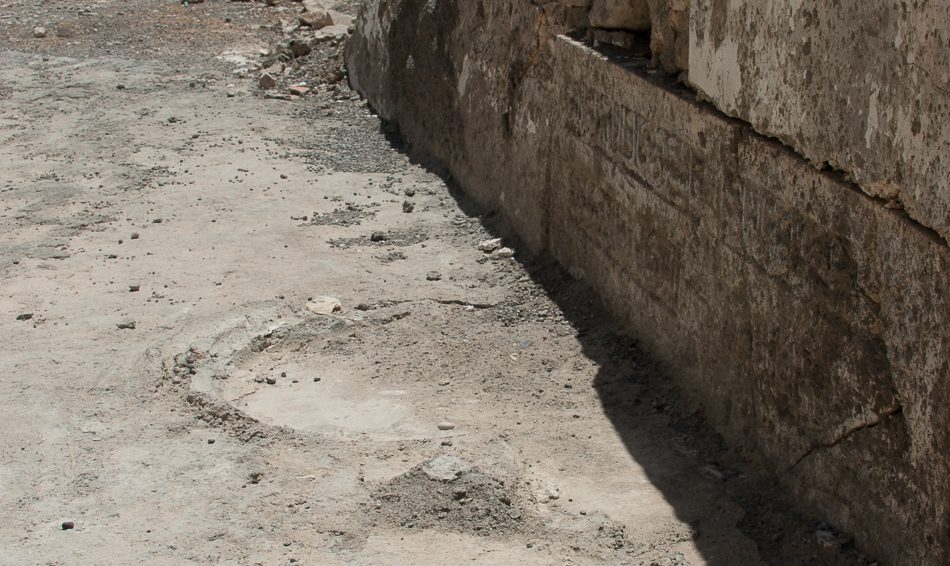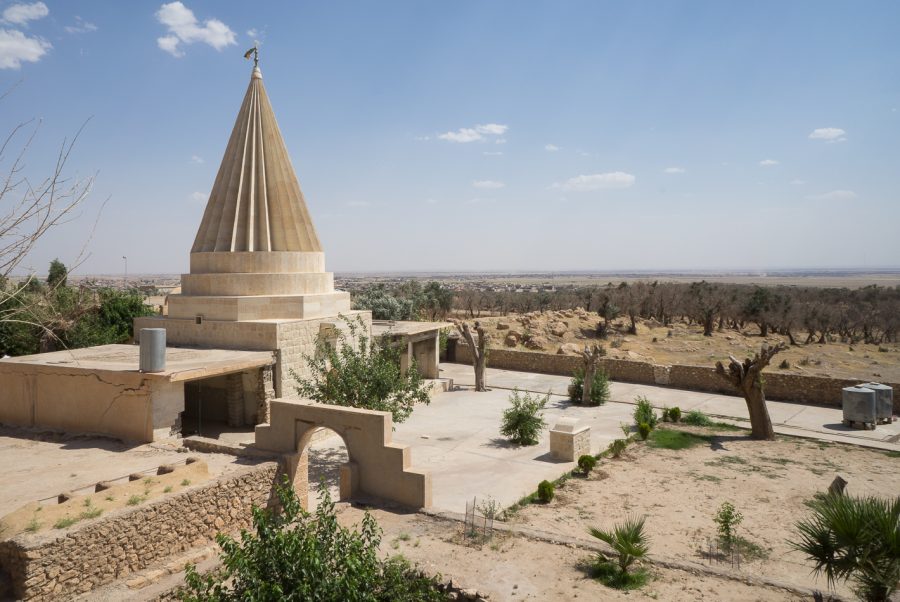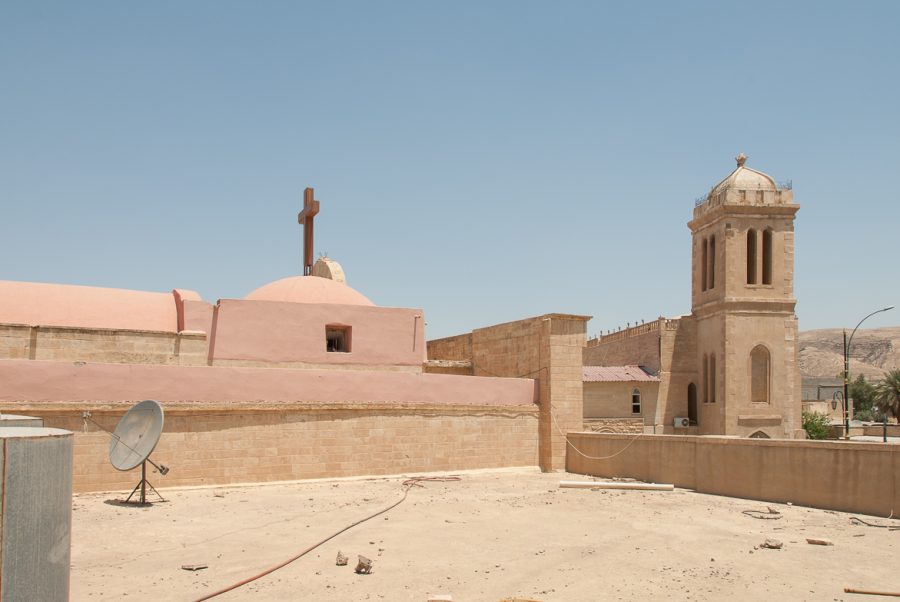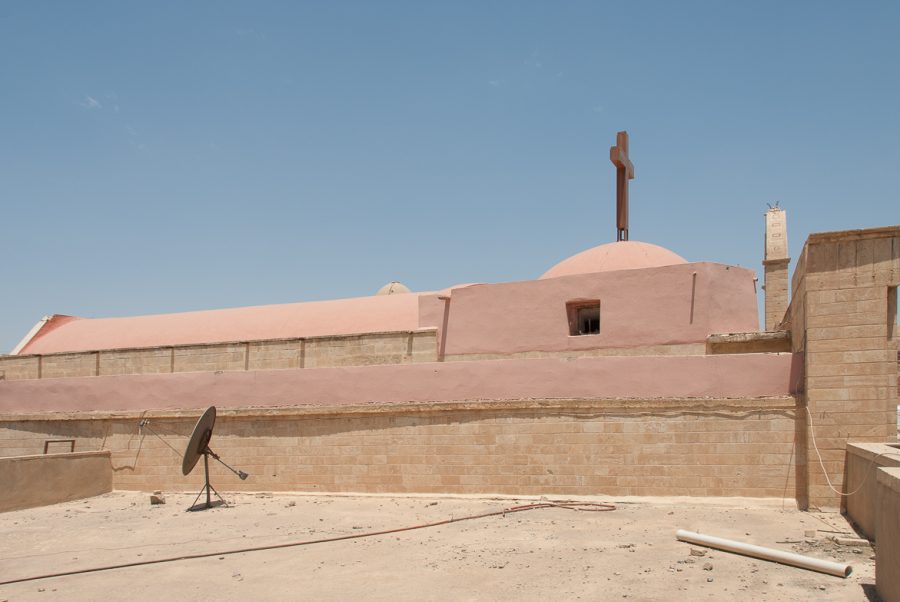The Yazidi mausoleum of Melek Miran in Bashiqa
The Yazidi mausoleum of Melek Miran in Bashiqa is located at 36°27’27.45″N 43°20’47.53″E and 366 metres altitude in the Nineveh province. This is a key sector, situated between the desert plains and the foothills of the Kurdistan mountains.
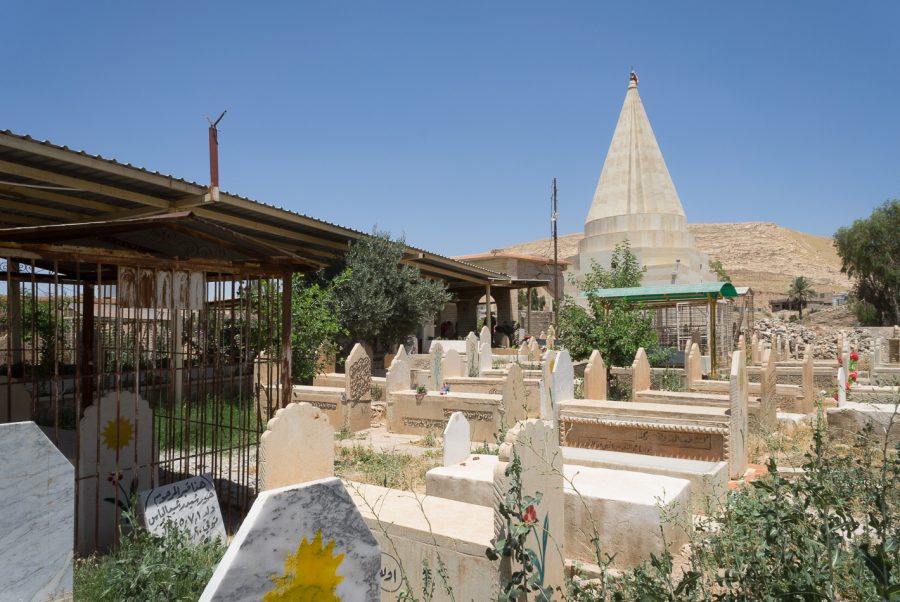
Bashiqa, together the neighbouring town of Bahzani, had the third largest population of Yazidi in Iraq, prior to the Sinjar massacre. This area is considered to be the intellectual heart of Yazidism. ISIS occupied the area from 7th August 2014 to 7th November 2016. The jihadists destroyed the 22 Yazidi mausoleums in Bashiqa and Bahzani. The Yazidi libraries found here were also reduced to dust. They even burned down the famous sacred olive grove in Bahzani. Despite the extent of the destruction, quite remarkably, all 22 of the mausoleums destroyed have been rebuilt with support from the Yazidi diaspora, but without any form of government aid.
Pic : The new Yazidi mausoleum of Melek Miran in Bashiqa. June 2018 © Pascal Maguesyan / MESOPOTAMIA
About this file
The content of this file has been drafted by Dr. Birgül Açıkyıldız-Şengül, art historian, specialised in Yazidi heritage and culture. Dr. Birgül Açıkyıldız-Şengül is an associate researcher at the University Paul Valéry Montpellier III and the IFEA Istanbul, and is the author of a doctoral thesis: “Yazidi heritage: Funeral architecture and sculptures in Iraq, Turkey and Armenia” presented in 2006 at the University Paris I Panthéon-Sorbonne (department of Islamic art and archaeology). This thesis contains a documented inventory of 88 monuments (sanctuaries, mausoleums, baptistries, oratories, caravanserai, bridges and caves) and 60 funeral sculptures (in the shape of horses, rams, sheep or lions) in northern Iraq, Turkey and Armenia. Thesis published by I.B.Tauris (London, New York), 2010. The text has been enriched with the observations and interviews of the Mesopotamia team (Pascal Maguesyan, Shahad al Khouri, Sibylle Delaître (KTO)) with support from Mero Khudeada.
Location
Bashiqa.[1] is located at 36°27’27.45″N 43°20’47.53″E and 366 metres altitude. The Yazidi city of Bashiqa, along with the neighbouring town of Bahzani, forms an urban agglomeration located 20 km to the north-east of the centre of Mosul, 15 km to the north of the Syriac-Orthodox city of Bartella, 30 km north of the Syriac-Catholic “capital” of Qaraqosh (Baghdede), 20 km south-west of the Syriac-Orthodox monastery of Mar Matta, 35 km south of the Yazidi city of Ain Sifni (Sheikhan) and finally, 48 km to the south of the Yazidi spiritual centre of Lalish
Geographically very different from the mountains and valleys of Sheikhan and Sinjar, Bashiqa and Bahzani can be considered to form the gateway to the heart of the Kurdish mountains and the Arab deserts.
_______
[1] There are varied spellings for Bashiqa. Dr. BirgülAçıkyıldız-Şengül uses the name “Bachîqe” in his work.
About the Yazidi in Iraq
Mainly settled in the autonomous region of Iraqi Kurdistan and the Nineveh plain, their geographic birthplace, there are also Yazidi in Turkey, Syria, and the Caucasus in particular in Armenia and Georgia. Generally considered as non-Islamic Kurds, which is at the very a least a simplistic if not inaccurate statement given their mythological origins, often demonised due to their religious practices, the Yazidi are a community whose historical origins and number are difficult to estimate.
Marginalized to the extreme in Iraq under various regimes, their existence was practically denied. Prior to 2003, Baghdad officially only recognised a few thousand whereas in reality there were no doubt closer to hundreds of thousands.
The conditions for an attempted genocide were already in place even before the ISIS jihadis started to massacre and kidnap Yazidi in the Sinjar mountains and province of Nineveh in August 2014.
Although the Iraqi forces and the coalition of resistance groups took back Sinjar in November 2015, the majority of the 500,000 – 600,000 Iraqi Yazidi are still displaced. The persecution they have suffered makes them fear for the future despite the constitutional guarantees afforded to them in 2005.
The territorial roots of Yazidism
Yazidism was founded in a mountainous territory where its inhabitants were protected by the slopes, peaks and caves. Considered sacred by the Yazidi, this territory roughly divides into two distinct regions, east and west of the Tigris, the key Mesopotamian river. To the west is Sinjar, the city, surrounding villages and the mountain range. To the east is the spiritual centre of Lalish, and the key sectors of Shekhan, Bozan, Bashiqa and Bahzani. The vast majority of the Yazidi population (including clergy) are from these regions although there are some scattered Yazidi communities outside of these areas.
For centuries, the Yazidi have preserved their customs and traditions in this region, this territory. This preservation of the past was cruelly undermined to the west of the Tigris in the Sinjar region by the devastating ISIS offensive in August 2014. The extent of the destruction and severity of the genocidal crimes committed severely weakened the Yazidi communities in the Sinjar mountains who previously formed the core of the Iraqi Yazidi population.
Territory, history and heritage
It is in this region, either side of the Tigris, that the Yazidi were able to preserve and develop the characteristic architectural features of their religious buildings which are the main places of worship for the Yazidi faithful.
These buildings are mostly dedicated to the first disciples of the 12th century Yazidi reformer, Sheikh ‘Adî, members of the Chamsani families and families such as Hasan Maman, Memê Rech and Cerwan, as well as the community’s first religious leaders, descendants of Sheikh ‘Adî (members of the Adani family) and certain important Sufi mystics who influenced Sheikh ‘Adî’s teachings, namely Abd al-Qadîr al-Jilani, al-Hallaj et Qedib al-Ban (Qadî Bilban).
However, it would be wrong to conclude that Yazidism is a medieval religion. The paucity of the theological and historical sources available is compensated for by the ancient tradition and mythology which are omnipresent and constantly developing. The Yazidi see Noah as one of their most ancient and most illustrious patriarchs. They even claim that he lived in Iraqi Mesopotamia, in Ain Sifni (Shekhan) where he built his ark. The Yazidi historians claim that “the Yazidi religion is very ancient. It goes back to 3,500 years BC.”[1]
The Yazidi have a wide diversity of places of worship and prayer, including cemeteries, mausoleums (mazar) some of which are larger than others (khas / mêr), fire oratories (nîshan), the houses of Sheikh or Pîr, trees, bushes, olive groves, bridges, arches, caves, sacred stones (kevir), springs etc. These monuments, structure and sites dedicated to the Yazidi “saints” constitute a large proportion of the cultural setting of the Yazidi communities and are the tangible, physical manifestation of the Yazidi belief system as a whole.
There is however, one fundamental place which all Yazidi turn to, including the diaspora: the Lalish valley in Iraqi Kurdistan. It is the most sacred place in Yazidism. It is the location of the sanctuary of Sheikh ‘Adî, the great reformer of Yazidism in the 12th century. This valley, its mausoleums and its environment are the centre of gravity of Yazidi spiritual life.
The Yazidi buildings were built at different times. The lack of inscriptions and historical sources make it difficult to date them accurately. The poor quality of some of the more recent restorations makes this analysis even more complex. Furthermore, there do not seem to be specific architectural styles associated with specific periods of Yazidi history which could help to date these buildings. In addition, the same style, derived from a specific model has been used at several times over the centuries and is still in vogue.
_______
[1] Chamo Kassem, inspector of Yazidi schools, specialist in Yazidi religion and culture, Head of Culture and Media, at the Lalish Cultural and Social Centre in Dohuk-Nohadra.
Fragments of Yazidi spirituality and theology
Yazidism is a religion based on tradition and oral history that is both simple and complex at the same time. Simple, because it is not regulated by a constraining liturgy or dogma. Complex, because there is no fundamental theological document underpinning it such as the Torah, the Gospels or the Koran. The Yazidi have two sacred books: the book of revelation “Kitêb-i Cilvê “, and the black book “Mishefa Reş”.
Yazidism is a strictly community-based religion (national). One is born Yazidi, you cannot become Yazidi. There is no evangelizing, inculturation or proselytizing. That said, Yazidism is not sectarian. Quite the opposite, altruism is considered to be a cardinal virtue, a spiritual and theological foundation. Any researchers interested in studying Yazidism are therefore warmly welcomed by the community and its clergy.[1]
Yazidism is a monotheism. God is singular and unique. He is the creator of the cosmos and of life. In this, Yazidism shares the same belief as the three main monotheist religions: Judaism, Christianity and Islam. As well as Zoroastrianism.[2]
God is light. He is like the sun which shines on the Earth. That is why the Yazidi systematically face the sun to pray. This is something Yazidism shares with Mesopotamian and Persian Zoroastrianism.
God is good, infinitely good. This is why the Yazidi encourage altruism and always pray firstly for the world and then for themselves.
God is everything and is everywhere. Yazidism is physically and spiritually one with the whole of Creation: cosmic, human, animal, vegetal, and mineral. That is why olive trees whose oil is used for the sacred fire are considered sacred by the Yazidi. Similarly, the angel peacock (tawûsê melek) is the most important of the seven angels (melek) which represent God on earth.
Yazidism believes in the judgement of souls and the last judgement. However, it differs from Christianity in its belief in reincarnation. The dead are buried. Their souls are judged according to the good and evil they have done. Pure souls become beings of light. Impure souls are reincarnated in devalued or bellicose human or animal forms.
_______
[1] “Jean-Paul Roux, who passed away in 2009, former CNRS researcher and head of the Islamic art section of the École du Louvre, considered Yazidism as “a standout religion, an obvious syncretism of popular tradition and reminiscences of the dogma of the major religions’’. La Croix, Claire Lesegretain, 26 April 2010.
[2] Born in Persia, founded by Zarathustra (Zoroaster) in the first millenium Before Christ, Zoroastrianism is monotheist and recognises Ahura Mazdâ as the only God. In this sense Zoroastrianism is fundamentally different from the Mazdaism it is derived from. Mazdaism is polytheist, considering Ahura Mazdâ as the main, but not the only, God. This Persian religion spread as far as India in the form of Vedism.
Yazidi worship
Yazidi worship is not governed by a strict liturgy but constitutes a set of traditional rites and votive practices passed on orally from generation to generation.
The Yazidi generally pray individually, but also gather together as a community at their temples and sanctuaries to listen to qawals, who are both musicians and the gatekeepers and guardians of the Yazidi religion, whose knowledge and practices are passed on from father to son.
The daily prayer, facing the sun, the light of God (Khoda), is not an obligation nor is it required to show you are a “good” Yazidi. However, pious, elderly people pray regularly, up to five times a day.
Kissing sacred places and the hands of saintly figures, offering gifts to consecrated persons, sacrificing animals, knotting and unknotting fabric on wish trees, are all signs of respect and devotion.
Wednesday is the most important day in the week. It is like Sunday for Christians, Saturday for Jews and Friday for Muslims. The main weekly services during which the Yazidi monks light the sacred fire in the mausoleums are held on Wednesdays.
Four major annual festivals are held during the Yazidi religious year. The first is the New Year (ser sal) celebrated on the first Wednesday of the month of April. This festival symbolises the creation of life out of the initial chaos and the coming of tawûsê melek. Eggs, a symbol of the original lifeless earth, are boiled and dyed as part of the celebrations. Some of these eggs are smashed above the doors of houses and mausoleums, mixed in with small red flowers.
Another major annual festival is the Spring festival (towaf), which is held on a date between 12th – 20th April. Finally, the pilgrimage to the tomb of Sheikh Adî, in the Lalish sanctuary (djamaiya) takes place on 6th October.
The mausoleum with a conical dome: characteristic Yazidi architecture
Mausoleums with a conical, striped dome are emblematic of Yazidi sacred art. Extremely sober in terms of its architecture and decoration, this type of building is built on a cube structure which contains the tomb or cenotaph, covered by a slab with a drum, above which stands a conical dome composed of multiple crests. This vault symbolises the sun’s rays which light up the earth and humanity.
The pinnacle of the dome is systematically fitted with a bronze spire formed of one or more spheres, mounted with a ring, a crescent moon, and a celestial body or hand, around which swathes of coloured fabric are knotted. The spire represents the cosmos, the planets, the sun and the stars created by God. The coloured fabrics represented the colours of the rainbow. [1]
The interior of a Yazidi mausoleum is often composed of a separate chamber containing a sarcophagus covered in silk fabrics. There are also often several niches carved into the walls to burn incense and light the sacred fire. These often also contain knotted fabrics placed there by pilgrims making wishes.
The sacred space in any Yazidi mausoleum includes the slab in front and around it. That is why any visitor or pilgrim must remove their shoes.
_______
[1] This interpretation can vary from one community to another.
Recent history and Yazidi demographics in Bashiqa and Bahzani
Although Bashiqa and Bahzani were already known to the Yazidi in the 12th century, and although there are no historical sources to confirm the supposition, it would appear that they only became part of their territory in the 13th century, when the Yazidi population left the Sheikhan region. This is backed up by the fact that the majority of the mausoleums located here are attributed to members of the second generation of the Chamsanis family, who lived in the second half of the 12th century.
Before ISIS invaded the Nineveh plain, there were 35,000 Yazidi living in Bashiqa and Bahzani [1]. They made up 85% of the population. The remainder was composed of 12% Christians and 3% Muslims..[2] The lightening progression of ISIS in 2014 forced the inhabitants of Bashiqa and Bahzani to flee the area in haste in the night of the 6th and 7th August. The area was liberated on 7th November 2016 and the inhabitants began to return as of January 2017, in 2018 around 27,000 Yazidi had returned, approximately 77% of the initial Yazidi population.[3] A further 735 Yazidi displaced from Sinjar who were studying in Mosul and were separated from their families are now living here in displaced persons camps. Finally, 525 houses were damaged by ISIS, 200 of which were totally destroyed.
Situated at the heart of the Nineveh plain, between Mosul and Sheikhan, on the edges of Mount Maqlub,[4], the urban area of Bashiqa and Bahzani had the third largest Yazidi population in Iraq prior to the Sinjar massacre. Whilst Bahzani constitutes the ancient sector with numerous ancient buildings, Bashiqa is modern in appearance and is mainly composed of new buildings. The spatial organisation, history and heritage of the area was wiped out by ISIS. The jihadists who occupied the area from August 2014 and November 2016 not only destroyed the 22 Yazidi mausoleums in Bashiqa and Bahzani, but they also reduced the Yazidi libraries in the area to dust, including the library of master qawal [5] Bahzad Suleyman Safode Bahzani, member of the council of five dignitaries surrounding Baba Sheikh. The Islamic assailants even burned down the famous sacred olive grove in Bahzani. This destruction was all the more devastating as Bashiqa and Bahzani were considered to be the intellectual centre of Yazidism in Iraq.
Remarkably, despite the extent of the damage, all 22 of the mausoleums destroyed by ISIS have been rebuilt, although many of the installations for which the region was renowned are still missing. The local Yazidi leaders told us that they received no financial support from the Iraqi government,[6]. However, it would seem that the Yazidi diaspora in Germany has been of vital assistance.
_______
[1] The most recent census in Iraq dates back to 1987. It reported a total of over 16 million inhabitants. In September 2018, the website of the Iraqi embassy in France stated that the estimated population of Iraq was 33 million inhabitants. This wide variation means that any analysis should be conducted with caution. In addition, there are the age-old difficulties of integrating the demographic reality of the Yazidi population in Iraq. With no reliable information available, the demographic data in this file are provided by the leaders of the Yazidi community and should therefore also be treated with caution.
[2] Data collected in Bashiqa by the Mesopotamia team on 9th June 2018, from the Yazidi community leaders in Bashiqa.
[3] 9th June 2018.
[4] The major Syriac-Orthodox monastery of Mar Matta is situated on Mount Maqlub.
[5] A qawal is a singer and instrumentalist but also a preacher. They are responsible for worship but also for passing on the Yazidi spiritual and liturgical heritage.
[6] This was consistently reported by all the Yazidi leaders we met with in the towns and villages visited by the Mesopotamia representative in June 2018.
The Yazidi mausoleums in Bashiqa
Bashiqa is home to 7 of the 22 mausoleums found in the Bashiqa-Bahzani urban area. All of these were blown up by ISIS. All of them have been rebuilt since the area was liberated. 90% of the gravestones were damaged with chisels. Some have been restored, renovated and replaced.
In Yazidi sacred architecture, the concept of space is expressed in separate, individual buildings. Although these were built for public use, they are separate from the residential spaces. Even in Bashiqa and Bahzani, where the majority of the Yazidi sacred spaces are located in the centre of the town, they are mostly built on hilltops, at a certain distance from the public spaces and are all systematically surrounded by a high-walled courtyard. With the exception of the mausoleum of Pîr Bûb, companion to the Yazidi reformer Sheikh Adi, all the mausoleums in Bashiqa and Bahzani are attributed to members of the Sheikh cast, and to the Chamsani line in particular.
Two out of the seven mausoleums in Bashiqa are detailed here as examples: the mausoleums of Melek Miran and Sheikh Muhammad.
The mausoleum of Melek Miran (described as it stood prior to its destruction by ISIS and as it stands today after its reconstruction). The mausoleum of Melek Miran is located in a Yazidi cemetery composed of numerous tombs from different periods and varied styles. A large number of tombstones were broken into pieces and a number of tombs desecrated between 2014 and 2016.[1]
Before the museum was destroyed by ISIS, the inscription above the door showed the date 1335/1916. This is probably the date it was founded.
In the Yazidi tradition, Melek Miran was one of their ancestors. He was born to a virgin mother. His mausoleum is reputed to have healing properties, notably for arthritis. Worshippers and pilgrims therefore take away earth and water from the stream which runs below the mausoleum. They mix this to form mud which they spread over their bodies to heal the disease.
Before it was destroyed by ISIS, the building had a square floor plan measuring 4.3 x 4.3 metres. The interior was accessed via two steps. There is a small niche in the wall to light wicks. The building contained five tombs of Yazidi saints surrounded by multi-coloured fabrics. It was mounted with a conical segmented dome with scaled squinches.
Rebuilt in 2017, as attested to in an inscription above the door, the rebuilt mausoleum presents more or less similar characteristics. It is no doubt a little less elegant. Furthermore, “the remains of the five saints which were buried in the mausoleum were not damaged, because they were at a depth of one metre. Only the coffins were destroyed but we repaired these.”[2]
The mausoleum of Sheikh Muhammed (as it stood prior to its destruction by ISIS). The building is located next to the mausoleum of his wife Sitt Hecici on a high hilltop. Sheikh Muhammad is the son of Sheikh Nasral-Dîn of the Chamsanî family. They are believed to have lived in the 14th century. He is famed for his combat against a mighty Sheikh. Decapitated whilst fighting the Sheikh’s followers, he picked up his head, placed it under his arm and continued to fight!
From the exterior, the mausoleum has a rectangular floor plan and is oriented from east to west. It is made up of two parts: the main section and the antechamber. The antechamber to the east can be accessed by a lowered door in the south wall. The antechamber has a rectangular floor plan measuring 3.2 x 2.4 metres. It is overlooked by a dome but the ceiling is flat on the outside. There is a coffin in the middle of the room, oriented from east to west. The two sections are connected by a semi-circular arch that is 1.6 metres wide.
The main section to the west has a square floor plan of 3.3 x 3.2 metres. There is a square niche in the west wall where votive wicks are lit. There is a larger coffin in this room, oriented from east to west. A conical dome with 32 segments dominates the room and stands on a two-level drum, with an octagonal then a circular level.
_______
[1] Melek Miran is called Meleke Mîran Sadiq by Dr Birgül Açıkyıldız-Şengül in his academic work.
[2]Source: Qawal Hussein Ali. 9th June 2018.
Testimony of Yazidi leaders in Bashiqa
Qawal Hussein Ali [1]: “This is not the first time we Yazidi have suffered like this. Over the course of our history, we have lived through 72 genocides!”[2]
“When you destroy a house it is painful for the people who live there, but when you destroy a mausoleum it affects everyone. Our mausoleums are thousands of years old. In Iraqi Mesopotamia we have a very ancient civilizational heritage. Damaging these places is a disaster for us.
After the reconstruction of the mausoleums we conducted a number of rites to make these spaces of worship fit for purpose again. We replaced the ancient crescent. The new crescent was baptised with water from Lalish. The ruins of the ancient mausoleum of Melek Miran were buried and we built on top of these.”
Djuma Alias Selim[3]: “The extremists still exist. The extremist mentality is still present, even though ISIS has been defeated. The Christians and Yazidi are victims of wars with the people they live with.”
We have no news of the 2,700 Yazidi who were kidnapped. There are 60 mass graves in Sinjar. These graves need to be protected with barriers but the government has done nothing. There are no less than 3,500 bodies in these graves. Most of them are elderly men and women.
_______
[1] Source: Qawal Hussein Ali. 9th June 2018.
[2] This is regularly repeated by the Yazidi.
[3] Source: Djuma Alias Selim, Head of the Lalish Cultural and Spiritual Centre in Bashiqa. 9th June 2018.
Monument's gallery
Monuments
Nearby
Help us preserve the monuments' memory
Family pictures, videos, records, share your documents to make the site live!
I contribute
